
16 Types Of Writing Every Writer Should Master
Discover our guide with types of writing you can use in your next writing assignment; there are many different forms of writing to explore today!
As someone who makes a living writing for other people’s websites, I often adapt my writing style for different audiences and situations. The way I write conveys meaning beyond the words I use or what I say. Some forms of writing paint a picture, convince readers to act, or communicate facts using reliable sources. Choosing from the different types of writing and adapting to the requirements of a professor, business, or client is crucial to writing success.
Below, I’ll share the different types of writing you can practice and learn how to become a better writer .
1. Expository Writing
2. narrative writing, 3. persuasive writing, 4. descriptive writing, 5. technical writing, 6. diary writing, 7. business writing, 8. copywriting, 9. content writing, 11. critical writing, 12. scientific writing, 13. travel writing, 14. blogging, 15. technical writing, 16. academic writing, the final word on types of writing, how do i choose the right writing style for a piece, how can i learn to write in various styles.

Expository writing focuses on providing facts and research about a given topic. With some forms of writing like this, you’ll explore an idea in detail and expand on that idea using factual statements.
When writing an expository essay, you don’t seek to prove a point, persuade, or evoke emotions. Your goal is to explain something in an objective and balanced way. Read our guide to the best essay writing topics . Here are some examples of expository writing you’re probably familiar with, whether you’ve written them or read them:
- Journalistic articles
- How-to manuals
- Assembly instructions
Stories are everywhere around you and provide ample opportunity to express your imagination.
In forms of writing like narrative writing, you tell a story that’s 100 percent truthful, primarily factual but embellished for reader enjoyment or fiction. Stories are everywhere around you and provide ample opportunity to express your imagination.
Examples of the narrative style include:
- Biographies and autobiographies
- Short stories
- Narrative journalism
The journalist Hunter S. Thompson popularized this type of writing in his articles and essays, whereby his journalism often reads like a novel. If you’d like to learn more about this style, read our guide to narrative essays .

In a persuasive essay, your goal is to convince the reader to agree with you through strategic argumentation. To accomplish this, you employ various argumentation techniques like presenting supporting evidence for your argument, laying out points logically that slowly generate buy-in from the reader, and telling a story that evokes emotion to make the case. Politicians and leaders use persuasive writing to popularize ideas like Barack Obama’s book The Audacity of Hope . If you’d like to learn more, read our guide to persuasive essays .
Examples of persuasive writing include:
- Advertisements and marketing campaigns
- Cover letters
- Letters of recommendation
- Business proposals
- Persuasive essays
- Persuasive social media posts
- Persuasive journalism
Descriptive writing is a type of writing style that overlaps with others in this list. It’s one of the most common types of writing, as students often write descriptive essays in school. One of the essential concepts in descriptive writing is to “show, not tell.” Rather than simply saying what happened, explain the how and the why behind it to paint a picture. If you’d like to learn more, read our guide to descriptive essays . You’ll use numerous literary devices to accomplish this, such as:
- Foreshadowing
For this writing style, you’ll choose a point of view to relate to readers. The POV can change the tone of the piece, with the third-person often sounding more formal and objective, while the first and second can seem informal. You may need a combination of more than one POV for the piece to work. Examples of POV usage:
- First-person – I, We
- Second person – You, Understood You
- Third-person – He, She, It, They
Technical writing involves communicating something complex in a way the audience can understand. To accomplish this, the technical writer must have in-depth knowledge of the topic they’re explaining and an understanding of the audience’s experience level. Technical writing is devoid of personal opinions. Instead, it explains a topic or concept step-by-step or logically. If you’d like to learn more, read our guide explaining how to become a technical writer . Examples of technical writing include:
- Research papers
- Legal documents
- Some textbooks
- White papers
- Academic writing
- Medical journals
- Technical documentation for products and software

Diary writing is a more personal form intended to log events in a person’s life and often their emotions. If you think you might be famous someday, keeping diaries could one day be resource materials for your auto-biography! Read our guide explaining the differences between a diary and a journal .
That point aside, many people use diaries as an external way to process how they’re feeling to deal with anger, regret, grief, fear, jealousy, and sadness. It’s cheaper than therapy. Diary writing can be a positive experience. People often write about what they’re grateful for, express their joy around fortuitous events, or set life goals and celebrate accomplishments.
Examples of diary writing include:
- The Diary of Anne Frank
- Leonardo Da Vinci’s diaries
- Charles Darwin’s diaries
- Marie Curie’s notebooks
Business writing is a commonly misunderstood type of writing. Many consider business writing stuffy and formal, but it’s a stimulating and well-paying field. A business writer follows a company style guide to convey an idea or concept for internal and, sometimes, external use.
For example, a business writer could take notes from an executive and turn them into a compelling business case for the wider team. They could also articulate the values of a business in everyday concise language for a presentation, pitch deck or company manifesto.
Copywriting describes using words to sell products and services to a target audience. A copywriter produces copy for websites, sales pages and email funnels. They aim to convince readers to act, for example, opting in for a lead magnet with their email address, taking out a trial or buying a product. A copywriter can also branch into social media and content writing. Copywriters can earn high-five and even six figures annually by providing this service to companies or clients.
The art of copywriting involves holding the attention of readers. For this reason, it’s a valuable skill for those writing online. A good copywriting formula can help a writer finish an article or blog post quickly. Learn how to become a copywriter .
Content writing is similar to copywriting. A content writer produces blog posts, articles, ebooks and guides for companies or online businesses. They may also write YouTube video scripts and social media posts.
A content writer typically charges clients a per-word rate, usually between four and ten cents, depending on the complexity of the topic. Content writing has become more popular for freelancers because most online businesses thrive on content.
A well-run niche website, for example, publishes a set number of SEO-optimized articles each month to increase traffic and revenue. The owner of this site depends on a team of knowledgeable content writers to achieve their publication and revenue goals. If you’d like to try this discipline, read our guide explaining what does a content writer do ?

Poetry is something most writers try for fun. It’s a surprisingly rewarding discipline as a writer can play around with words, imagery and sensory language. Usually, an aspiring poet isn’t trying their hand at this type of writing to supplement their income. Instead, it’s a creative challenge .
Perhaps the most accessible type of poetry to start with is Haiku. It’s a type of Japanese poetry whereby the first line contains five syllables, the second 7 and the third 5. Haiku is only one form of poetry to explore. Read our guide to the most common types of poetry . For example, consider this ancient Haiku by Japanese poet Matsuo Bashō:
An old silent pond A frog jumps into the pond— Splash! Silence again. – Matsuo Bashō
A critic considers a piece of popular media and analyzes it for a general audience. The most obvious example is a film critic who watches a film and then explains whether readers should watch it in newspaper articles or online.
Critical writing is often subjective rather than objective because it’s written from the reviewer’s point of view. After all, one person’s art is another’s trash! However, writing reviews requires deep knowledge and understanding of the topic or medium in question… or at least an ability to entertain readers with your point of view. Popular forms of critical writing include:
- Film reviews
- Game reviews
- Music reviews
Scientific writing involves writing literature reviews, peer-reviewed journal papers, and grant proposals. They read the prevailing literature about a topic, review current thinking and then provide a synopsis and evaluation. A scientific writer backs up their argument or points with evidence and citations. Ideally, a scientific writer demonstrates precision, clarity and objectivity.
However, they’re usually writing for an expert audience who understands the topic, prevailing literature or works in the field. Therefore, a scientific writer doesn’t always have to explain basic concepts and ideas as they can assume their audience knows the basics.

Travel writing describes writing about your experiences while visiting a country, city or location. It sounds like a glamorous profession because you get paid to go on holiday! However, professional travel writers are often under strict deadlines and must see and do as much as possible quickly. That often cuts out any socializing. Travel writers also face competition from locals who can write about a location with more expertise than a visitor. Travel writers can earn a nice side income by blogging and writing about their trips online. For more, read our guide explaining how to become a travel writer .
Blogging is an immensely rewarding form of writing that started in 1997. If you’re going to start a blog today, expect competition. Reportedly, over 600 million blogs exist worldwide.
However, a writer can find success more easily if they write within a specific niche about topics readers are searching for, rather than their day or personal lives. The best blogs are self-hosted on WordPress and monetized through display advertising, affiliate promotions, and digital products. To learn more, read our guide to blogging for writers .
Technical writing is a specialized skill where writers take complex information and display it in a way that’s easy for readers to understand. Often, technical writing involves creating diagrams, graphs, charts and visuals to help explain the topic. Various sectors like finance, technology, IT, healthcare and STEM utilize technical writers to create articles and guides on specific topics. For more, learn how to get paid to write reviews .
Academic writing is used for all scholarly contexts, like school essays or college dissertations. It will almost always follow a structure and usually follows formatting guidelines like MLA or APA. Writing for academic purposes will involve research and narrative in a passive or third-person voice to maintain objectivity. Many resources are available to help with academic writing; check out our guide with the best essay-writing apps to get started.
Writers can explore many different styles, from creative to commercial. Selecting the right one depends on the reader, editor, publication, and writing goals . If you’re bored with one style, you can always try another for fun or to flex your creative muscles.
FAQs About Types Of Writing
Consider your audience and the style guide for the publication in question. Identify what type of writing the editor expects for this topic, publication, situation, or brand. Consider how your piece can inform, educate, inspire or entertain readers.
Reading their examples is one of the best ways to learn writing styles. Notice how the writer grabs your attention, unfolds their main points, and communicates with you. Then practice, and ask someone–preferably a writer–to give you some feedback.

Meet Rachael, the editor at Become a Writer Today. With years of experience in the field, she is passionate about language and dedicated to producing high-quality content that engages and informs readers. When she's not editing or writing, you can find her exploring the great outdoors, finding inspiration for her next project.
View all posts

Choose Your Test
Sat / act prep online guides and tips, understanding the 4 writing styles: how to identify and use them.
General Education

A piece’s writing style can help you figure out what kind of writing it is, what its purpose is, and how the author’s voice is unique. With so many different types of writing, you may think it’s difficult to figure out the specific writing style of a piece or you'll need to search through a long list of writing styles.
However, there are actually just four main types of writing styles, and together they cover practically all the writing you see, from textbooks to novels, to billboards and more. Whether you’re studying writing styles for class or trying to develop your own writing style and looking for information, we’ve got you covered.
In this guide, we explain the four styles of writing, provide examples for each one, go over the one thing you need to know to identify writing style, and give tips to help you develop your own unique style of writing.
The 4 Types of Writing
There are four main different styles of writing. We discuss each of them below, list where you’re likely to see them, and include an example so you can see for yourself what each of the writing styles looks like.
Writers who use the narrative style are telling a story with a plot and characters. It’s the most common writing style for fiction, although nonfiction can also be narrative writing as long as its focus is on characters, what they do, and what happens to them.
Common Places You’d See Narrative Writing
- Biography or autobiography
- Short stories
- Journals or diaries
“We had luncheon in the dining-room, darkened too against the heat, and drank down nervous gayety with the cold ale. ‘What’ll we do with ourselves this afternoon?’ cried Daisy, ‘and the day after that, and the next thirty years?’ ‘Don’t be morbid,’ Jordan said. ‘Life starts all over again when it gets crisp in the fall.’ ‘But it’s so hot,’ insisted Daisy, on the verge of tears, ‘and everything’s so confused. Let’s all go to town!’ - The Great Gatsby by F. Scott Fitzgerald
You can quickly tell that this passage from the novel The Great Gatsby is an example of narrative writing because it has the two key traits: characters and a plot. The group is discussing eating and drinking while trying to decide what to do for the rest of the day.
As in this example, narrative writing often has extended dialogue scenes since the dialogue is used to move the plot along and give readers greater insight into the characters.
Writers use the expository style when they are trying to explain a concept. Expository writing is fact-based and doesn’t include the author’s opinions or background. It’s basically giving facts from the writer to the reader.
Common Places You’d See Expository Writing
- Newspaper articles
- Academic journals
- Business memos
- Manuals for electronics
- How-to books and articles
“The 1995/1996 reintroduction of gray wolves (Canis lupus) into Yellowstone National Park after a 70 year absence has allowed for studies of tri-trophic cascades involving wolves, elk (Cervus elaphus), and plant species such as aspen (Populus tremuloides), cottonwoods (Populus spp.), and willows (Salix spp.). To investigate the status of this cascade, in September of 2010 we repeated an earlier survey of aspen and measured browsing and heights of young aspen in 97 stands along four streams in the Lamar River catchment of the park’s northern winter range. We found that browsing on the five tallest young aspen in each stand decreased from 100% of all measured leaders in 1998 to means of <25% in the uplands and <20% in riparian areas by 2010. Correspondingly, aspen recruitment (i.e., growth of seedlings/sprouts above the browse level of ungulates) increased as browsing decreased over time in these same stands.” -”Trophic cascades in Yellowstone: The first 15 years after wolf reintroduction” by William J. Ripple and Robert L. Beschta
This abstract from an academic journal article is clearly expository because it only focuses on facts. The authors aren’t giving their opinion of wolves of Yellowstone, they’re not telling a story about the wolves, and the only descriptions are number of trees, streams, etc. so readers can understand the study better.
Because expository writing is focused on facts, without any unnecessary details or stories, the writing can sometimes feel dense and dry to read.
Descriptive
Descriptive writing is, as you may guess, when the author describes something. The writer could be describing a place, person, or an object, but descriptive writing will always include lots of details so the reader can get a clear and complete idea of what is being written about.
Common Places You’d See Descriptive Writing
- Fiction passages that describe something
“In a hole in the ground there lived a hobbit. Not a nasty, dirty, wet hole, filled with the ends of worms and an oozy smell, nor yet a dry, bare sandy hole with nothing in it to sit down on or eat: it was a hobbit hole and that means comfort. It had a perfectly round door like a porthole, painted green, with a shiny yellow brass knob in the exact middle. The door opened on to a tube-shaped hall like a tunnel: a very comfortable tunnel without smoke, with panelled walls, and floors tiled and carpeted...” - The Hobbit by J.R.R. Tolkien
This is the opening passage of the novel The Hobbit . While The Hobbit is primarily an example of narrative writing, since it explores the adventures of the hobbit and his companions, this scene is definitely descriptive. There is no plot or action going on in this passage; the point is to explain to readers exactly what the hobbit’s home looks like so they can get a clear picture of it while they read. There are lots of details, including the color of the door and exactly where the doorknob is placed.
You won’t often find long pieces of writing that are purely descriptive writing, since they’d be pretty boring to read (nothing would happen in them), instead many pieces of writing, including The Hobbit , will primarily be one of the other writing styles with some descriptive writing passages scattered throughout.
When you’re trying to persuade the reader to think a certain way or do a certain thing, you’ll use persuasive writing to try to convince them. Your end goal could be to get the reader to purchase something you’re selling, give you a job, give an acquaintance of yours a job, or simply agree with your opinion on a topic.
Common Places You’d See Persuasive Writing
- Advertisements
- Cover letters
- Opinion articles/letters to the editor
- Letters of recommendation
- Reviews of books/movies/restaurants etc.
- Letter to a politician
“What General Weygand called the Battle of France is over. I expect that the battle of Britain is about to begin. Upon this battle depends the survival of Christian civilization. Upon it depends our own British life, and the long continuity of our institutions and our Empire. The whole fury and might of the enemy must very soon be turned on us. Hitler knows that he will have to break us in this island or lose the war. If we can stand up to him, all Europe may be free and the life of the world may move forward into broad, sunlit uplands. But if we fail, then the whole world, including the United States, including all that we have known and cared for, will sink by the lights of perverted science. Let us therefore brace ourselves to our duties, and so bear ourselves, that if the British Empire and its Commonwealth last for a thousand years, men will still say, ‘This was their finest hour.’ - “This was their finest hour” by Winston Churchill
In this excerpt from his famous “Their finest hour” speech, Prime Minister Winston Churchill is clearing trying to convince his audience to see his viewpoint, and he lays out the actions he thinks they should take. In this case, Churchill is speaking to the House of Commons (knowing many other British people would also hear the speech), and he’s trying to prepare the British for the coming war and convince them how important it is to fight.
He emphasizes how important the fight will be (“Upon this battle depends the survival of the Christian civilization.” and clearly spells out what he thinks his audience should do (“Let us therefore brace ourselves to our duties…”).

Common Writing Styles to Know
Each of the four main types of writing styles has multiple subsets of styles within it. Here are nine of the most common and important types of writing you’ll see.
Narrative Writing
Character voice.
Character voice is a common writing style in novels. Instead of having an unknown narrator, the audience knows who is telling the story. This first-person narrator can help the reader relate more both to the narrator and the storyline since knowing who is telling a story can help the reader feel more connected to it. Sometimes the narrator is completely truthful in telling what happens, while other times they are an unreliable narrator and will mislead or outright lie to readers to make themselves look better.
To Kill a Mockingbird (Scout is the narrator) and The Hunger Games (Katniss is the narrator) are two examples of this writing style.
Stream-of-Consciousness
This writing style attempts to emulate the thought process of the character. Instead of only writing about what the character says or does, stream-of-consciousness will include all or most of the characters thoughts, even if they jump from one topic to another randomly or include incomplete thoughts.
For example, rather than writing “I decided to take a walk to the ice cream shop,” an author using the stream-of-consciousness writing style could write, “It’s pretty hot out, and I feel like I should eat something, but I’m not really that hungry. I wonder if we have leftovers of the burgers Mom made last night? Is Mom staying late at work tonight? I can’t remember if she said. Ice cream would be a good choice, and not too filling. I can’t drive there though because my car is still in for repairs. Why is the repair shop taking so long? I should have listened when David said to check for reviews online before choosing a place. I should text David later to see how he is. He’ll think I’m mad at him if I don’t. I guess I’ll just have to walk to the shop.”
James Joyce and William Faulkner are two of the most well-known writers to have regularly used the stream-of-consciousness writing style.
Epistolary writing uses a series of documents, such as letters, diary entries, newspaper articles, or even text messages to tell a story. They don’t have a narrator, there’s just whoever purportedly gathered the documents together. This writing style can provide different points of view because a different person can be the author of each document.
Well-known examples of epistolary writing include the novels Dracula (written as a series of letters, newspaper articles, and diary entries) and Frankenstein (written as a series of letters).
Expository Writing
You’ll find this style in textbooks or academic journal articles. It’ll focus on teaching a topic or discussing an experiment, be heavy on facts, and include any sources it cited to get the information. Academic writing often assumes some previous knowledge of the topic and is more focused on providing information than being entertaining, which can make it difficult to read and understand at times.
Business writing refers to the writing done in a workplace. It can include reports, memos, and press releases. Business writing typically has a formal tone and standard formatting rules. Because employees are presumably very busy at work, business writing is very concise and to the point, without any additional flourishes intended to make the writing more interesting.
You’ll see this writing style most commonly in newspaper articles. It focuses on giving the facts in a concise, clear, and easy-to-understand way. Journalists often try to balance covering all the key facts, keeping their articles brief, and making the audience interested in the story.
This writing style is used to give information to people in a specific field, such as an explanation of a new computer programming system to people who work in software, a description of how to install pipes within a house for plumbers, or a guide to new gene modifications for microbiologists.
Technical writing is highly specialized for a certain occupational field. It assumes a high level of knowledge on the topic, and it focuses on sharing large amounts of information with the reader. If you’re not in that field, technical writing can be nearly impossible to understand because of the jargon and references to topics and facts you likely don’t know.

Descriptive Writing
Poetry is one of the most challenging styles of writing to define since it can come in many forms. In general, poems use rhythmic language and careful word choice to express an idea. A poem can be an example of descriptive writing or narrative writing, depending on whether it’s describing something or telling a story. Poetry doesn’t need to rhyme, and it often won’t follow standard grammatical or structural rules. Line breaks can, and often do, occur in the middle of sentences.
Persuasive Writing
Copywriting.
Copywriting is writing that is done for advertising or marketing purposes. It’s attempting to get the reader to buy whatever the writer is trying to sell. Examples of copywriting include catalogs, billboards, ads in newspapers or magazines, and social media ads.
In an attempt to get the reader to spend their money, copywriters may use techniques such as descriptive language (“This vanilla was harvested from the lush and exotic island of Madagascar"), exciting language (Stop what you’re doing and learn about this new product that will transform your life!”) and exaggeration (“This is the best cup of coffee you will ever taste!”).
Opinion
People write opinion pieces for the purpose of stating their beliefs on a certain topic and to try to get readers to agree with them. You can see opinion pieces in newspaper opinion sections, certain blog posts, and some social media posts. The quality of opinion writing can vary widely. Some papers or sites will only publish opinion pieces if all the facts in them can be backed up by evidence, but other opinion pieces, especially those that are self-published online, don't go through any fact-checking process and can include inaccuracies and misinformation.
What If You’re Unsure of a Work’s Writing Style?
If you’re reading a piece of writing and are unsure of its main writing style, how can you figure which style it is? The best method is to think about what the purpose or main idea of the writing is. Each of the four main writing styles has a specific purpose:
- Descriptive: to describe things
- Expository: to give facts
- Narrative: to tell a story
- Persuasive: to convince the reader of something
Here’s an example of a passage with a somewhat ambiguous writing style:
It can be tricky to determine the writing style of many poems since poetry is so varied and can fit many styles. For this poem, you might at first think it has a narrative writing style, since it begins with a narrator mentioning a walk he took after church. Character + plot = narrative writing style, right?
Before you decide, you need to read the entire passage. Once you do, it’ll become clear that there really isn’t much narrative. There’s a narrator, and he’s taking a walk to get a birch from another man, but that’s about all we have for character development and plot. We don’t know anything about the narrator or his friend’s personality, what’s going to happen next, what his motivations are, etc.
The poem doesn’t devote any space to that, instead, the majority of the lines are spent describing the scene. The narrator mentions the heat, scent of sap, the sound of frogs, what the ground is like, etc. It’s clear that, since the majority of the piece is dedicated to describing the scene, this is an example of descriptive writing.

How Can You Develop Your Own Writing Style?
A distinctive writing style is one of the hallmarks of a good writer, but how can you develop your own? Below are four tips to follow.
Read Many Different Styles of Writing
If you don’t read lots of different kinds of writing, you won’t be able to write in those styles, so before you try to get your own writing style, read different writing styles than what you’re used to. This doesn’t mean that, if you mostly read novels, you suddenly need to shift to reading computer manuals. Instead, you can try to read novels that use unreliable narrators, stream-of-consciousness writing, etc.
The more you read, the more writing styles you’ll be exposed to, and the easier it’ll be able to combine some of those into your own writing style.
Consider Combining Multiple Types of Writing Styles
There’s no rule that you can only use one style for a piece of writing. In fact, many longer works will include multiple styles. A novel may be primarily narrative, but it can also contain highly descriptive passages as well as expository parts when the author wants the readers to understand a new concept.
However, make sure you don’t jump around too much. A paper or book that goes from dense academic text to impassioned plea for a cause to a story about your childhood and back again will confuse readers and make it difficult for them to understand the point you’re trying to make.
Find a Balance Between Comfort and Boundary-Pushing
You should write in a style that feels natural to you, since that will be what comes most easily and what feels most authentic to the reader. An academic who never ventures outside the city trying to write a book from the perspective of a weathered, unschooled cowboy may end up with writing that seems fake and forced.
A great way to change up your writing and see where it can be improved is to rewrite certain parts in a new writing style. If you’ve been writing a novel with narrative voice, change a few scenes to stream-of-consciousness, then think about how it felt to be using that style and if you think it improved your writing or gave you any new ideas. If you’re worried that some writing you did is dull and lacking depth, add in a few passages that are purely descriptive and see if they help bring the writing to life.
You don’t always need to do this, and you don’t need to keep the new additions in what you wrote, but trying new things will help you get a better idea of what you want your own style to be like.
The best way to develop your own writing style is to expose yourself to numerous types of writing, both through reading and writing. As you come into contact with more writing styles and try them out for yourself, you’ll naturally begin to develop a writing style that you feel comfortable with.
Summary: The 4 Different Styles of Writing
There are four main writing styles, and each has a different purpose:
If you’re struggling to figure out the writing style of a piece, ask yourself what its purpose is and why the author wants you to read it.
To develop your own writing style, you should:
- Read widely
- Consider mixing styles
- Balance writing what you know and trying new things
What's Next?
Literary devices are also an important part of understanding writing styles. Learn the 24 literary devices you must know by reading our guide on literary devices.
Writing a research paper for school but not sure what to write about? Our guide to research paper topics has over 100 topics in ten categories so you can be sure to find the perfect topic for you.
Are you reading The Great Gatsby for class or even just for fun? Then you'll definitely want to check out our expert guides on the biggest themes in this classic book, from love and relationships to money and materialism .

Christine graduated from Michigan State University with degrees in Environmental Biology and Geography and received her Master's from Duke University. In high school she scored in the 99th percentile on the SAT and was named a National Merit Finalist. She has taught English and biology in several countries.
Student and Parent Forum
Our new student and parent forum, at ExpertHub.PrepScholar.com , allow you to interact with your peers and the PrepScholar staff. See how other students and parents are navigating high school, college, and the college admissions process. Ask questions; get answers.

Ask a Question Below
Have any questions about this article or other topics? Ask below and we'll reply!
Improve With Our Famous Guides
- For All Students
The 5 Strategies You Must Be Using to Improve 160+ SAT Points
How to Get a Perfect 1600, by a Perfect Scorer
Series: How to Get 800 on Each SAT Section:
Score 800 on SAT Math
Score 800 on SAT Reading
Score 800 on SAT Writing
Series: How to Get to 600 on Each SAT Section:
Score 600 on SAT Math
Score 600 on SAT Reading
Score 600 on SAT Writing
Free Complete Official SAT Practice Tests
What SAT Target Score Should You Be Aiming For?
15 Strategies to Improve Your SAT Essay
The 5 Strategies You Must Be Using to Improve 4+ ACT Points
How to Get a Perfect 36 ACT, by a Perfect Scorer
Series: How to Get 36 on Each ACT Section:
36 on ACT English
36 on ACT Math
36 on ACT Reading
36 on ACT Science
Series: How to Get to 24 on Each ACT Section:
24 on ACT English
24 on ACT Math
24 on ACT Reading
24 on ACT Science
What ACT target score should you be aiming for?
ACT Vocabulary You Must Know
ACT Writing: 15 Tips to Raise Your Essay Score
How to Get Into Harvard and the Ivy League
How to Get a Perfect 4.0 GPA
How to Write an Amazing College Essay
What Exactly Are Colleges Looking For?
Is the ACT easier than the SAT? A Comprehensive Guide
Should you retake your SAT or ACT?
When should you take the SAT or ACT?
Stay Informed
Get the latest articles and test prep tips!
Looking for Graduate School Test Prep?
Check out our top-rated graduate blogs here:
GRE Online Prep Blog
GMAT Online Prep Blog
TOEFL Online Prep Blog
Holly R. "I am absolutely overjoyed and cannot thank you enough for helping me!”

- Join for Free

5 Types of Writing Styles Plus Examples
- by Domestika @domestika
Discover different writing styles to level up your communication and captivate your audience through words
Your writing style says a lot about you as a creative. Depending on the one you opt for, it also has the power to inspire powerful emotions and actions in your readers. From persuasive to narrative and expository, we take a look at five of the most common forms of writing, along with how you can put them into practice to reach your creative goals.
You don’t need to be an experienced writer to apply these methods. Below, you’ll find courses taught by leading professionals that are designed to help you to express yourself from scratch.
1. Creative writing
In theory, creative writing applies to all the styles on this list but, for Shaun Levin, it refers to writing about topics you’re passionate about. He teaches creative writing in colleges, schools, and art galleries alongside publishing works like Alone with a Man in a Room , Seven Sweet Things , and Snapshots of The Boy .
Shaun shares practical exercises you can do to enhance your creative writing in his course, Creative Writing for Beginners: Bringing Your Story to Life . Explore ideation, perspective, narrative styles, materials, observation, and beyond to sharpen your skills as a writer and bring your interest to life on the page.
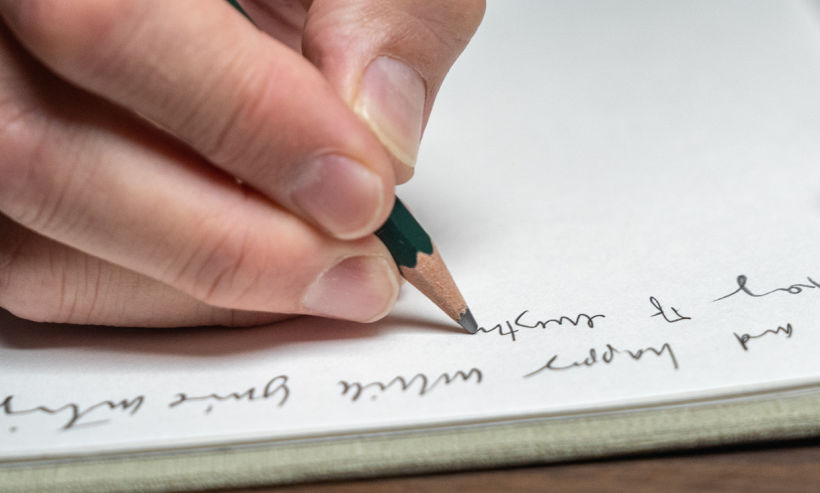
2. Narrative writing
Narrative writing is all about creating stories—something we naturally do as human beings all the time, often without realizing. With over 25 years of experience as an author and creative writing teacher, it’s what Alberto Chimal specializes in. He has published over forty novels and collections of short stories with the aim of bringing people together.
In his online course, Introduction to Narrative Writing , he teaches you how to write memorable stories step by step. Discover the fundamental parts of a story, including the plot structure and emotions, along with the different genres you can opt for, and start writing narratives that captivate your audience.

3. Persuasive writing
Persuasive writing, as its name suggests, is a style designed to incite action. Whether it’s for a campaign aimed at boosting sales, or a poster you want to stop people in the street, knowing how to craft persuasive copy in the right tone is essential for any brand. That’s where the profession of copywriting comes in.
In this course, taught by senior copywriter Paul Anglin, you’ll learn to craft copy that grabs people’s attention on social media . Having worked with brands like Apple, Nike, and Microsoft, it’s something Paul has a wealth of experience in. Join him and discover how to brainstorm ideas, develop them with insight, and deliver them creatively to tell your brand’s story.

4. Descriptive writing
When it comes to documenting moments and memories, words can be just as powerful as photographs. With descriptive writing, the key is in the detail. By describing an event at length with the senses in mind, you can invite readers to experience it for themselves.
Travel Journaling: Document Feelings and Memories , taught by author Aniko Villalba, is an online course dedicated to showing you the basics of descriptive writing. She has published several books such as Dias de viaje and El sindrome de Paris , as well as interactive diaries including Mapa subjetivo de viaje . Follow her steps and learn how to document your thoughts and feelings through writing.

5. Expository writing
In contrast to descriptive writing, which relies on personal interpretation, expository writing is based on facts. This style is most commonly found in newspapers, journals, and technical articles with the aim of providing information. If you’re interested in pursuing a career in journalism or publishing, expository writing is a skill you’ll need to master.
Paco Herranz is a journalist who specializes in teaching his craft to others. Since working for a renowned Spanish newspaper and reporting on events around the globe, he now shares his knowledge on writing in the Journalism, Edition, Production, and New Technologies master's program at the CEU San Pablo University, as well as through classes on the history of journalism at the University Carlos III of Madrid.
In this course, he teaches you the fundamental journalistic techniques and genres , from interviewing to news reporting, as well as how to use them to write stories.

Develop your writing skills further:
- See all of Domestika’s online writing courses .
- Learn the keys to writing a novel with writer Cristina López Barrio.
- Check out Shaun Levin’s other course and learn to write from personal experience, Short Story Writing: Create Fiction from Personal Experience .
- New to this craft and not sure where to start? Discover these simple writing exercises to make it a part of your daily routine.
Recommended courses

Writing Exercises: From the Blank Page to Everyday Practice
A course by Aniko Villalba
Engage in creative writing exercises that document and generate ideas, and transform it into a regular practice
- 98% ( 1.2K )

Writing a Novel Step by Step
A course by Cristina López Barrio
Learn the keys to writing a novel and stimulate your imagination with practical exercises that connect you with your inner world
- 98% ( 2.4K )

Copywriting for Social Media
A course by Paul Anglin
Learn how to write effective copy to attract and engage your brand's audience
- 98% ( 1.3K )
- Follow Domestika
ThinkWritten
The 4 Main Types of Writing Styles and How to Use Them as a Writer
Understanding the 4 main types of writing styles can help you grow as a writer and attract an audience for your written work. Here’s how to identify each style of writing and tips for using each of the 4 common writing styles to develop your written skills.

We may receive a commission when you make a purchase from one of our links for products and services we recommend. As an Amazon Associate we earn from qualifying purchases. Thank you for support!
Sharing is caring!
One of the things that can help you grow as a writer is to learn the 4 main types of writing styles and use the characteristics of each to further develop your own personal voice as a writer.
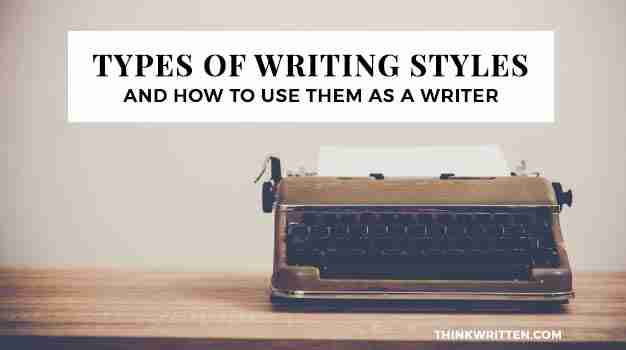
By learning how to use the different writing styles in your work, you will not only improve your skills as writer, but also learn ways to better connect with your audience of readers.
In this post we’ll cover the 4 main types of writing styles and how to use them as a writer to create compelling books, stories, essays, poetry, articles and more.
What are Writing Styles?
Writing styles are basically another way of saying the form or type of written work you are creating. Think of it as a classification for being able to identify what kind of writing you are creating.
For example, if you are writing a cookbook, that is a completely different style of writing than if you were writing a steamy romance novel!
Each writing style has a different purpose – and therefore, different characteristics are present when you are writing each type of different work.
Now that we understand what a writing style is – let’s talk about the 4 main writing styles which are commonly talked about amongst writers and literary educators.
The 4 Main Writing Styles & What They Mean
The four main writing styles which are commonly recognized are expository , descriptive , narrative , and persuasive .
Style #1: Expository
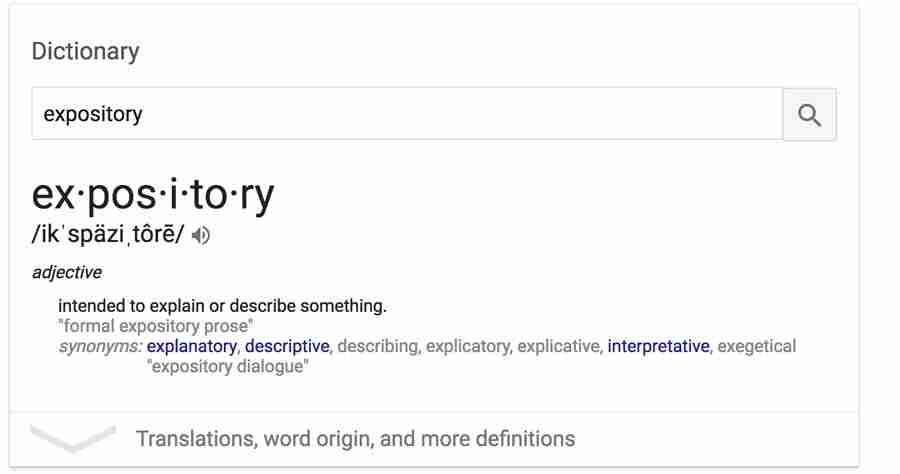
The definition of expository is this: “intended to explain or describe something.”
Most types of written work that fall into this category explain something in more detail, or provide insight and instruction in regards to a particular topic.
What types of writing fall into this category of expository writing style?
While there are many different types of written work which can be categorized as expository style of writing, you can often identify this type of writing by noticing the purpose of the work.
- Does the work intend to explain something in more detail?
- Does the written piece inform?
- Does the written piece answer questions such as “what, how and why?”

Here are some examples of the different types of writing pieces which can fall into the category of expository writing:
- Newspaper and Magazine Articles {not including editorials}
- Non-Fiction Books
- How-To Books
- Self Help Books
- Writing about Hobbies & Interests
- Recipes & Cookbooks
- Instructional Guides
- Scientific Research
- Textbooks & Educational Resources
- Business Articles & Books
- Medical Research, Journals and Articles
When you write expository style pieces, your main goal as a writer is to inform your readers with insight and facts that pertain to the subject of your piece.
For example, if you are writing about the history of ice cream, you would be including a lot of research and fun facts into your piece.
Note that this type of writing style is not intended to persuade or influence your audience. In writing your piece on the history of ice cream, you would NOT be trying to persuade your readers.
You would not want to say things like “Everybody should eat ice cream!” and “These 5 reasons will convince you forever to choose strawberry swirl flavored ice cream as your favorite flavor.”
Sometimes it can be confusing on whether an article is expository or persuasive. For example, an article called “The 5 Unexpected Health Benefits of Ice Cream” – would not fall into expository writing, even though it is providing information.
The word “benefits” has a positive connotation to the title. If you were to be writing an article on possible health benefits on ice cream, it would be very important that you as the writer keep your opinion separated from the facts and information if you plan for it to be an expository style piece. To be expository in nature, you would want to use a title such as “Scientists Research The Health Effects of Ice Cream.”
Books and articles that explain how to do something are also very popular examples of expository writing. Cookbooks are very popular, as they explain to others the tips, techniques, and recipes on how to cook something. How-to books for hobbies and crafts are also a good example of this type of writing.
Style #2: Descriptive Writing

Descriptive writing goes deeper than expository writing. While expository writing might have some descriptive details and factual information, descriptive writing will make use of many writing elements and literary devices such as metaphors and similes.
The purpose and goal of descriptive writing is to bring your reader into the written work as if the reader were to be experiencing it first hand.
Most fictional pieces fall under the category of descriptive writing, and even some non-fiction pieces such as memoirs and creative non-fiction can fall under the category of a descriptive writing style.
If you are writing fiction, the more descriptive you can be with your words, the more relatable your story will be to the reader.
For example, we recommend that writers ask their characters questions as one way to really intimately understand the details about a character. Details about the setting, events, and people present in a story will help your readers be able to imagine and understand the piece.
This style also includes poetry. If you browse through some of our poetry writing prompts , you will see there is a lot of attention put on using details to create a scene or feeling in writing a poem!
Here are some examples of types of descriptive writing pieces:
- Poetry & Prose
- Travel Diaries
- Personal Journals
- Lyrics in Music and Songwriting
Most pieces using only a descriptive writing style are not very long. It is uncommon for a fictional novel to be 100% fully descriptive without getting into our next writing style, which is narrative writing.
Style #3: Narrative Writing

Narrative writing is far more complex that simple descriptive writing.
While a poem for example may describe a scene or even events or people – generally you do not get into the deep inner thoughts of the characters or even get a full story with a clear middle, beginning, and end complete with conflict and dialogue.
Nearly all fiction novels fall into the case of narrative writing, as well as longer epic poems and sagas.
In narrative writing, there is a story to be told – a clear plot complete with setting, characters, dialogue, conflict and resolution. A narrative piece often has a timeline or sequence of events which further build to the point of conflict and resolution.
Here are some examples of the works which would be considered to have a narrative writing style:
- Fiction Novels
- Memoirs & Biographies
- Screenplays
- Myths, Legends, and Fables
- Historical accounts
- Essays which talk about a lesson learned or valuable insight from an experience
Narrative writing pieces are generally easy to identify, although sometimes it can be confused with descriptive writing styles. The key difference in determining which one a written work might be is whether or not there is a developed storyline or plot.
If there is a well developed plot and storyline, you are most likely reading narrative writing.
Style #4: Persuasive Writing

Persuasive writing is a type of writing style where the purpose is to influence someone into believing or doing something. As the word “persuasive” suggests – your goal is to persuade someone’s actions or thoughts to align with your own goals as the writer.
The persuasive writing essay is a popular homework assignment for many kids. For example, a student might be assigned to write an essay to convince their parents of something. “Why We Should Get a Pet Rabbit” and “5 Reasons You Should Not Make Me Clean My Room”.
Persuasive writing is intended to convince someone of something, and so it usually needs to have a good bit of research and logical analysis – but also should attempt to make an emotional connection to the desired audience as well.
A classic piece of writing which serves as an example of persuasive writing is Thomas Paine’s book Common Sense , which was written in the Colonial times of the American Revolutionary War, urging citizens that separating from England was of utmost importance.
Here are some examples of types of writing which are persuasive writing:
- Editorial & Opinion pieces in Newspapers and Magazines
- Essays on a specific belief or “hot button” topic
- Letters written to request an action or file a complaint
- Advertisements {Convincing you to buy something}
- Copywriting {Note, copywriting is different from copyright!}
- Company Brochures
- Business Proposals
- Political speeches
When the intention of the work is to convince the audience of something – this falls into persuasive writing.
How to Use the 4 Main Different Writing Styles as a Writer
Now that we know the different types of writing styles, you may be wondering how do you use each style?
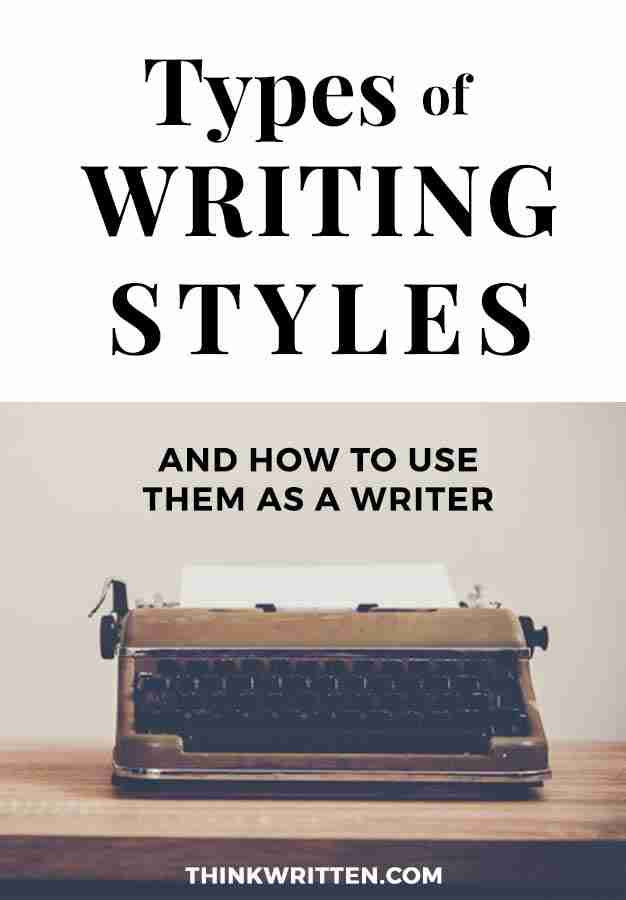
The first thing to do is think about what you are planning to write and what the intention is. What is your goal and what type of message are you trying to communicate to your readers?
Expository Style Writing:
In this type of writing your goal is to inform your readers about research or data.
When writing expository style pieces, follow these guidelines:
- Avoid using words which have a positive or negative connotation
- Do not insert your opinion or attempt to persuade your audience into thinking, feeling, or doing something based on your beliefs
- Use research and cite your sources
- When writing online, link to additional resources or websites
- Use quotes, illustrations or informative graphics to highlight the information
- Give concise and clear directions
Descriptive Writing Style:
This type of writing has the goal to describe something and bring into your reader’s imaginations
Here are some tips for writing with descriptive writing styles:
- Use literary devices such as metaphors and similes.
- Use well thought out adjectives and adverbs to describe nouns and verbs.
- Bring attention to small details
- Use the 6 senses: sight, touch, taste, smell, sound, and feeling
Narrative Writing Style:
In narrative writing style, your goal is to convey a storyline to your readers.
Here is how to achieve this type of writing style:
- Outline a storyline, plot or timeline sequence of events
- Include detailed descriptions of your characters and scenes
- Give your readers insight into the inner thoughts or behind-the-scenes information to elements of your story
- Answer the 6 W questions in your writing: Who, What, When, Where, How, and Why?
- Make it so your piece of work conveys an important lesson or insight – what is the moral of the story? What was the outcome of this experience?
- Use concrete language which gives readers a specific image to visualize and relate to
Persuasive Writing Style:
When you are writing to persuade, your intention is to convince your readers to side with you. This can be as simple as convincing them to buy your latest new product, or even writing about important social and humanitarian issues.
Here are some tips for writing persuasively:
- Include information, data, and facts to back up your argument
- Cite your sources and give readers access to additional information
- Appeal to your readers on an emotional level – how will siding with your opinion connect with them and make them feel?
- Take into consideration your reader’s needs, wants, and desires and how your message will help your reader achieve these.
Understanding Writing Styles Can Help You Be a Better Writer
No matter what type of writing you enjoy creating – understanding the basic main 4 types of writing styles can help you become a better writer.
If you are writing a how-to article for example, you will be able to understand what types of elements to ensure your piece of work includes. If you’re writing a descriptive poem, knowing what type of language to use can help convey your message for abstract concepts.
Use these different writing styles as a fun writing exercise!
Even if you typically only write for one style, it can be a lot of fun to push yourself to try to write for the different types of styles. For example, try writing a persuasive essay, and then a descriptive essay on the same topic. It can also be fun to write a descriptive poem and then turn it into a narrative essay or short story.
Not sure what to write about using these different writing styles? We have TONS of ideas for you with many different writing prompts! Check out our list of 365 writing prompts ideas which are sure to inspire your creative muse!
Using prompts is a great way to help you start writing in different writing styles and push yourself to a new exciting challenge for your writing skills!
I hope this article about the different writing styles and how you can use them as a writer will be helpful for you in building and developing your written skillset.
What types of writing styles do you enjoy writing the most? Have any tips for writing in expository, descriptive, narrative or persuasive styles of writing? We’d love to hear your ideas and experiences in the comments section below!
Chelle Stein wrote her first embarrassingly bad novel at the age of 14 and hasn't stopped writing since. As the founder of ThinkWritten, she enjoys encouraging writers and creatives of all types.
Similar Posts

How to Outline a Novel Plot in 5 Easy Steps
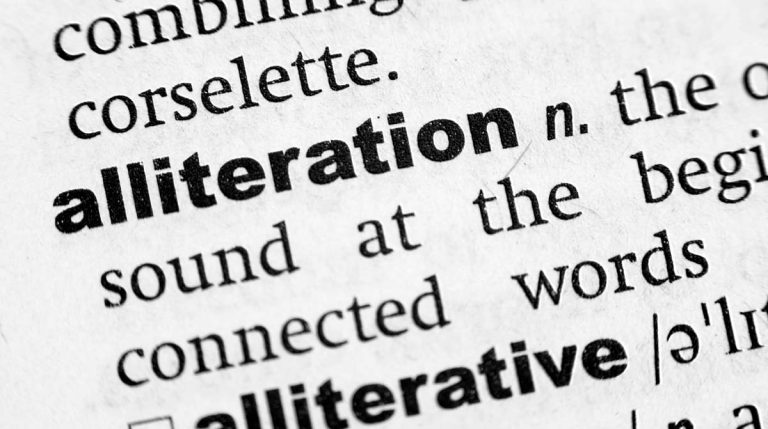
Alliteration Examples and How to Use it in Your Writing

How to Mind Map a Novel Plot
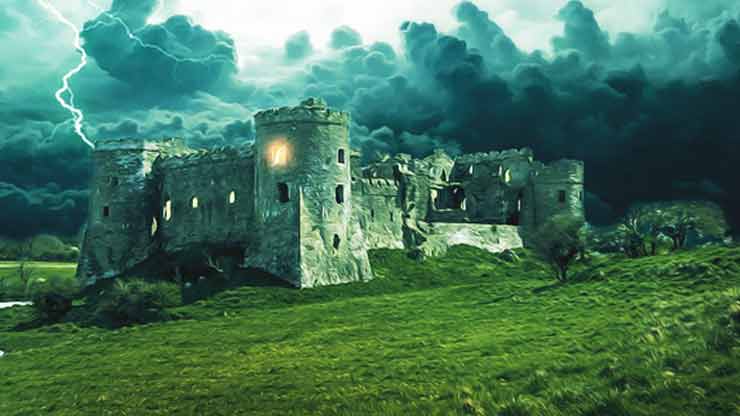
5 Signs of a Strong Novel Plot

7 Rules of Punctuating Dialogue: How to Punctuate Dialogue Easily
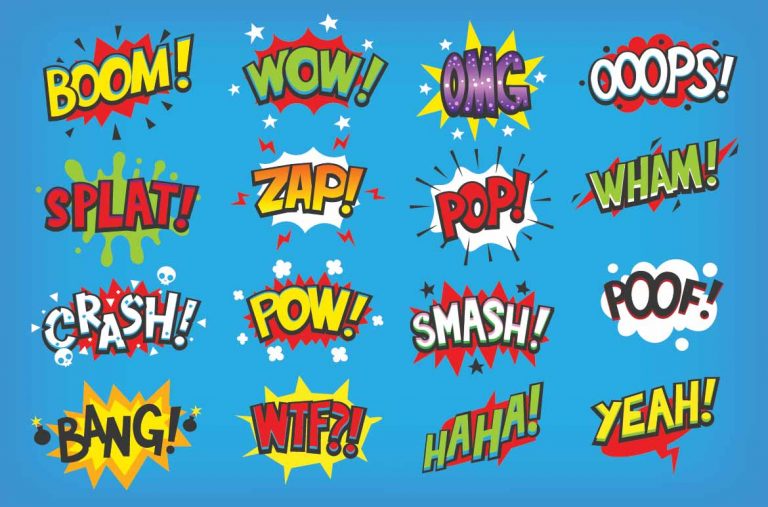
Onomatopoeia: Words List & Examples
15 comments.
Enjoyed reading this artice. I stumbled across this website by chance and I don’t regret it. Best thing I read today. I am sure this information will be pretty helpful for my Notes in future. Thank you. 👍
Thank you! Glad you found it helpful 🙂
I am grateful I came across this article. It will come in handy in my writing work
Great! This is very helpful.
I am glad it is helpful for you Nazz!
I teach English to non-native speakers and I stress, on a regular basis, about the value of being able to write as well as speak. So when I stumbled across this article I had to post it to my linkedIn page.
Very informative article! Thank you.
Wow! Very exciting article. This help me rebuild my bad foundation. I have really had hard times writing a piece to finish. I never get to communicate my message the way i intend to because i get to a cross road of how best to relate with my audience with clarity. Quite EXPOSITORY! thanks
It’s really helpful 😊 it’s worth.
very helpful
To which writing style would a conversational manner apply best?
A writing that talks about the cages people Live can be classified as what type?
Great work!
Thanks Very useful It will be very helpful for me as a writer. I really appreciate this words of wisdom and knowledge. It was very insightful.
An article one can easily connect with. It brings clarity and understanding to the different writing styles as discussed. Kudos.
Leave a Reply Cancel reply
Your email address will not be published. Required fields are marked *
Save my name, email, and website in this browser for the next time I comment.
A Guide to 13 Different Types of Writing Styles with Examples And Features
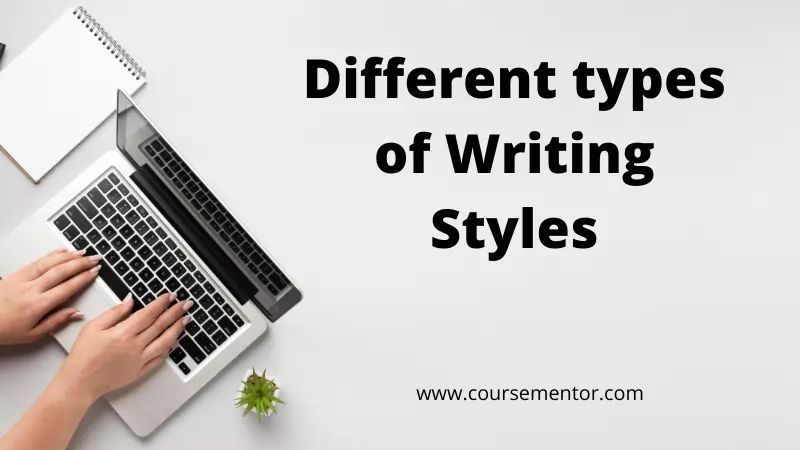
- Post author By admin
- October 10, 2022
If you want to become a strong writer for a job or fun, this isn’t an easy task. If you think this is as easy as writing anything on paper, you’re wrong. However, there are different types of writing styles that are used for different types of purposes.
On the other hand, there are many types of writers. Are they all the same? Of course not. As a result, different writing styles are used for different situations, and where to use them is the most important step to becoming a professional writer.
Most writers find themselves writing a specific niche like poetry, novel, non-fiction, etc. Well, this will happen because you might relate yourself to it.
However, if you get into writing, you are probably confused, and you have different questions in your mind like, What are the different types of writing styles? Which one is more used in writing? How are they different from each other? And many more like that.
Without wasting any time, let’s find out What is Writing style? And then we move to its types.
Table of Contents
What is Writing Style?
The author’s unique way of communication with words is called writing style. The author usually creates a style with the voice and tone that they apply to their text. On the other hand, the type of writing depends on the type of writing, the audience, and who they are writing for. Each writer has their style, which may vary from project to project. However, you will find some authors that maintain a cohesive writing style. Below are the different types of writing styles that a writer uses.
13 Different Types Of Writing Styles That You Should Know (With Examples)

In this blog, we cover 13 types of styles used in writing with suitable examples. We gave you an example for each writing style because it’s easier to understand something new than to read its definition, which might be boring sometimes.
List of different types of writing styles as follow:
- Narrative Writing
- Expository Writing
- Descriptive Writing
- Persuasive Writing
- Creative Writing
- Technical Writing
- Review Writing
- Poetic Writing
- Objective Writing
- Subjective Writing
- Academic writing
- Journalistic writing
- Business writing
What is Narrative Writing?
The main aim of narrative Writing is to tell people what happens somewhere or with someone. If you just started working as a writer or if you’re writing your first book, then narrative writing is the writing style you want to focus on. On the other hand, narrative Writing includes both fiction and non-fiction. Whereas non-fiction is based on real events, fiction writing is completely made up.
Example of Narrative Writing:
- Short-story.
- Presentations
- Speeches, and many more.
Supreme Features of Narrative Writing:
- Written in the first person.
- Storytelling in written form.
- It requires great imagination by the writer.
This is the first writing style on the list of 13 different types of writing styles.
What is Expository Writing?
Expository writing is used to educate or explain a particular topic to its reader. So the main goal of expository writing is to teach the reader about something rather than entertainment—questions like when, who, what, where, and why are answered in the expository writing.
This writing style is used to educate something to the reader, so no personal opinion of the writer is used in this type of writing.
Example of Expository Writing:
- Scientific Writing.
- Technical Writing.
- Recipes writing.
- blogs, flipbook animations and many more
Supreme Features of Expository Writing:
- Objective tone.
- Written in the third person.
- Static facts.
This is the second writing style on the list of 13 different types of writing styles.
What is Descriptive Writing?
In this writing, the author writes about every aspect of the person, place, or event, describing all aspects in detail. Descriptive writing makes the reader feel as if they are present there.
Example of Descriptive Writing:
- Copywriting.
- Narrative Nonfiction.
- Fictional Stories.
Features of Descriptive Writing:
- Personal tone.
- Use Detail-oriented Writing.
This is the third writing style on the list of 13 different types of writing styles.
What is Persuasive Writing?
Persuasive writing is used to convince the reader about something, a certain opinion or idea is the best one. This type of writing is written when the author has a strong opinion on something or encourages people to take action regarding any issue.
Example of Persuasive Writing:
- Essay.
- Cover letter.
- An opinion piece in the newspaper.
- Sales writing.
Features of persuasive writing:
- Personal opinion.
- Written in the first or third person.
- Persuasive tone.
What is Creative Writing?
Creative writing is the style of writing where the author breaks the boring writing structure and thinks outside of the box. As a result, the main aim of creative writing is to surprise the reader and storyteller in a completely different way.
In other words, creative writing is the art of making things up. Any Writing that requires imagination comes under the type of creative writing.
Example of creative Writing:
- Screenwriting.
- Flash fiction.
- Biographies.
- Script-writing.
Main features of creative writing:
The main feature of Creative Writing is that you make your content as creative as it can get.
What is Technical Writing?
Technical writing is mainly used for educational texts or professional documents. Technical writing is all about writing on a special point that is more logical or on scientific purpose.
Example of Technical Writing:
- Medical articles,
- User-manuals of any kind, etc.
Feature of Technical Writing:
- It is totally based on Facts-Driven points.
What is Review Writing?
As the name suggests, the main aim of this type of writing is to write reviews for various things.
Nowadays, this type of writing is more popular due to the digitization of everything. People rarely shop for anything without reading reviews online.
Example of Review Writing:
- Service reviews. For example, washing service, car service, basically any service.
- Book reviews.
- Product reviews.
Feature of Review writing:
- It requires persuasive writing and good description writing skills.
What is Poetic Writing?
In this type of writing, the writer uses rhythm and rhyme to convey the story of the idea. This type of writing is broadly used for fiction. However, it is also used in metaphor or in similarity.
Some examples of Poetic Writing where it is used: This type of writing is mainly used in
- Short Stories.
- Used to provide Rhythmic structure.
- Uses various poetic devices.
What is Objective Writing?
Objective writing is a type of writing where the writer is supposed to prove something, any facts or evidence. In this writing, the writer must remain unbiased about the topic so the reader can form their own opinion. It is mainly used for presenting a neutral point of view toward a specific idea and for formal writing.
Example of Objective Writing:
- Assertive texts.
- Mostly text that is written for educational purposes.
- Use a neutral tone.
- Evidence-based idea.
- Pure factual.
What is Subjective Writing?
Subjective writing is used to showcase the author’s feelings, opinions, and preferences on things. In other words, this type of writing style originated from the writer’s personal experience. In this writing style, the author need not bother about the accuracy and correctness of the writing.
Example of Subjective Writing:
- Opinionated pieces.
- Travelogues, and many more.
Features of Subjective Writing:
- It is mainly written in the first person.
- It shows the personal thoughts and opinions of the author.
What is Academic Writing?
The type of writing used in school or university-related publications is called the academic style. You will find this kind of writing in school journals, books, or academic research.
It is of two types,
Student academic writing
Expert academic writing.
Students use this academic writing style for their paper research, assignments, etc.
This is used for publications, for example, academic books, journals, study material, etc.
These writing styles follow the same structure and standards but differ only depending on the user.
Examples of Academic Writing:
- Research papers
- Case studies
- Literature reviews
- Theses and dissertations
- Academic journal articles
- Conference papers
Features of Academic Writing:
- Formal language
- Objective tone
- Structured format
- Evidence-based arguments
- Correct and consistent
What is Journalistic Writing?
This type of writing style is used for news-related content. You will find this type of writing style in newspapers, magazines, online news content, and many more.
The main purpose of this writing type is to provide information to the people in a clear and concise manner
Examples of Journalistic Writing:
- News articles
- Feature stories
- Editorial pieces
- Investigative reports
Features of Journalistic Writing:
- Inverted pyramid structure
- Clear and concise language
- Quotes and sources
What is Business Writing?
This type of writing style is used for professional and business content, for example, emails, memos, reports, etc. This is the purposeful writing style that is used for providing relevant information to the reader in a clear, effective, and concise manner.
Examples of Business Writing:
- Business letters
- Marketing materials
Features of Business Writing:
- Clarity and concision
- Audience focus
- Professional tone
- Action-oriented language
Different Types Of Writing Styles – Tabular Form
5 most used tips to choose correct writing style, formal/informal writing.
The writer should not switch between Formal and Informal tones of writing. Basically, most writing styles are formal.
Language Compatibility
For the beginner writer who is still working on upgrading their writing skills, it is advised that you do not use complex language that not only your reader could not understand but also don’t have any idea about what you are writing.
Requirement
It is the most important step to know what writing style will go best with the idea that you wish to write. For example, if you want to share your opinion on an issue that you believe others should too, go for a persuasive writing style.
The tone determines how the text makes the reader feel about the topic while reading the text. The tone is an important feature in determining the kind of audience interested in its subject. Hence the writer must set the tone according to their need.
It refers to the atmosphere that the writer creates in their work. The mood of the written work can be humorous, angry, optimistic, etc.
Above all are the five tips used in different types of writing styles
Conclusion:
You can easily categorize your thoughts according to your needs once you know the different types of writing styles .
If you stick with one style of writing, then you limit your creativity. But if you want to expand your limit, it is advisory to work with a different academic style.
Lastly, you don’t have to bind yourself to a single form of writing, even if you are good at it. The most important point is to identify what your audience wants and know what will create the biggest impact on them.
Also, Read: Types of Tones in Writing
Frequently Asked Question?
What is the most difficult writing style.
Comedy is considered the most difficult style of writing. The main reason behind that is this type of writing is too subjective.
What are writing techniques?
The writing is meant to be the style and structure the writer uses to give his or her message to the reader in a clear and meaningful way.
- australia (2)
- duolingo (13)
- Education (264)
- General (63)
- How To (16)
- IELTS (127)
- Latest Updates (162)
- Malta Visa (6)
- Permanent residency (1)
- Programming (31)
- Scholarship (1)
- Sponsored (4)
- Study Abroad (187)
- Technology (12)
- work permit (8)
Recent Posts


Types of Writing Styles
There are four main types of writing: expository, descriptive, persuasive, and narrative. Each of these writing styles is used for a specific purpose. A single text may include more than one writing style.
Expository writing is one of the most common types of writing. When an author writes in an expository style, all they are trying to do is explain a concept, imparting information from themselves to a wider audience. Expository writing does not include the author’s opinions, but focuses on accepted facts about a topic, including statistics or other evidence.
Examples of Expository Writing
- How-to articles
- News stories (not editorials or Op-Eds)
- Business, technical, or scientific writing
Descriptive
Descriptive writing is often found in fiction, though it can make an appearance in nonfiction as well (for example, memoirs, first-hand accounts of events, or travel guides). When an author writes in a descriptive style, they are painting a picture in words of a person, place, or thing for their audience. The author might employ metaphor or other literary devices in order to describe the author’s impressions via their five senses (what they hear, see, smell, taste, or touch). But the author is not trying to convince the audience of anything or explain the scene – merely describe things as they are.
Examples of Descriptive Writing
- Journal/diary writing
- Descriptions of Nature
- Fictional novels or plays
Persuasive writing is the main style of writing you will use in academic papers. When an author writes in a persuasive style, they are trying to convince the audience of a position or belief. Persuasive writing contains the author’s opinions and biases, as well as justifications and reasons given by the author as evidence of the correctness of their position. Any “argumentative” essay you write in school should be in the persuasive style of writing.
Examples of Persuasive Writing
- Cover letters
- Op-Eds and Editorial newspaper articles
- Reviews of items
- Letters of complaint
- Advertisements
- Letters of recommendation
Narrative writing is used in almost every longer piece of writing, whether fiction or nonfiction. When an author writes in a narrative style, they are not just trying to impart information, they are trying to construct and communicate a story, complete with characters, conflict, and settings.
Examples of Narrative Writing
- Oral histories
- Novels/Novellas
- Poetry (especially epic sagas or poems)
- Short Stories
About Writing: A Guide Copyright © 2015 by Robin Jeffrey is licensed under a Creative Commons Attribution 4.0 International License , except where otherwise noted.
The 4 Main Writing Styles: Definitions, Examples, and Techniques
by Kaelyn Barron | 2 comments

Most written work falls under one of four writing styles: expository, descriptive, narrative, or persuasive.
If you don’t remember taking a quiz on these in the fifth grade, don’t worry. More than likely, you’re already internalized some of their key characteristics without even realizing it.
A quick review of these styles and their techniques can help you become a better writer, while also becoming a more conscious reader.
The 4 Writing Styles
Before you get to punching away at your keyboard, you should ask yourself: Why am I writing this? Is it to explain? Describe? Teach? Persuade? Entertain?
You may achieve several of these in one piece, but focusing in on one purpose can help you to identify the appropriate style, and therefore the right techniques.
Knowing the differences between these four styles and their most common techniques won’t just make you a more effective writer—you’ll also be a more conscious reader. For example, you’ll be able to readily identify persuasive techniques in advertisements, and easily separate facts from opinions.
In this post, we’ll discuss the four main styles of writing, their traits, common examples, and tips for how you can practice each of them more effectively.
Style 1: Expository Writing
Expository writing is written with the intent of explaining or describing something. (That may seem easy to confuse with descriptive writing, but we’ll clarify the difference in the next section.)
If you’re writing an expository piece, you’ll rely almost exclusively on facts to answer the questions of what, why, and how.
Most forms of journalism, for example, fall under the expository category because the writing is intended to “expose” the facts. It’s also the style being used in this post, because the purpose is to inform you of the four writing styles and their qualities, and not to persuade you to use one over the other.
Other examples of expository writing include:
• News articles • Manuals • How-To/Self-Help books • Textbooks • Research journals and articles • Instructional guides • Cookbooks • Encyclopedia articles • Historical research
If expository writing is your intended style, be careful to avoid inserting your own opinions, which is called editorializing. Unfortunately, this part can sometimes be tricky.
Note, for example, that articles titled “5 Great Benefits of Meditation” or “10 Reasons You Should Start the Keto Diet” carry positive connotations. Even if you reference dozens of facts to support your claim, such articles should still be considered persuasive writing.
Self-help books can also be examples of expository writing, but only when they consist of researched facts. Someone might present an excellent sales pitch for their newly developed diet plan, but if they adorn their facts with persuasive language, we can’t consider their book an expository piece.
To prevent this conflation between expository and persuasive styles, try using neutral phrases, like: “Studies show that meditating five minutes a day is linked to lower blood pressure.”
In this way, you can still list the “benefits” of something, but you’ll leave it to your audience to decide if that’s the right label.
Tips for Solid Expository Writing
• Present facts, not opinions • Answer a what, why, or how question • Reference experts or trusted sources when possible • Leave your personal bias at the door • Include descriptive details, but use neutral adjectives
Style 2: Descriptive Writing
Descriptive writing allows much more creative freedom than expository, because writers are free to use imaginative language to describe a subject.
The main purpose of descriptive writing is to paint a picture in the reader’s mind of a person, place, or thing. This is best achieved through imagery and other literary devices, including similes, metaphors , and personification.
While writers have more freedom with the adjectives they choose, some words, such as “beautiful,” might not be the best descriptors. Instead, try to include more sensory details to really paint a picture for your readers.
For example, what makes the girl “beautiful”? Is it her thick, raven hair? Her melodic laughter? The loping way she walks? These details help create a more vivid image in the reader’s mind, as opposed to simple adjectives that can be open to interpretation.
By being as detailed as possible, descriptive writing can pull readers into an experience. This makes it an ideal style for many forms of fiction, including poems and songs.
Other examples of descriptive writing include:
• Personal diaries • Travel journals • Product descriptions in catalogs
Writers should take care to not overwhelm their readers with adjectives, however. Piling detail on top of detail can start to feel ridiculous. Focus instead on using powerful language to describe a handful of details that really help build the image. Literary devices like similes or metaphors can also be great alternatives to laundry lists of adjectives.
Tips for Solid Descriptive Writing
• Use sensory details: don’t just tell readers how something looks; when possible, tell them how it feels, sounds, smells, moves, or tastes • Use literary devices, such as similes and metaphors • Don’t overdo it—sometimes a little can go a long way
Style 3: Narrative Writing
Narrative writing includes most novels and works of fiction. Unlike most poems or other types of descriptive writing, narrative style involves a much more developed plot and characters.
To develop a plot, you’ll have to think about many factors: the setting, the characters, the main conflict, the resolution, the timeline, and the relationship between all of these.
Whereas descriptive writing can be considered a window through which we can view a character or thing, narrative writing should typically present the full picture.
Other examples of narrative writing include:
• Novels • Film or television screenplays • Epic poems • Memoirs • Short stories • Fables
It is worth noting that narrative writing isn’t limited to just fictitious content. Even stories of real-life events, along with memoirs and biographies, can be considered narrative writing so long as they tell a story with a plot, character(s), and setting.
While it would require another post to tell you everything about writing a great novel , here are some things to remember when starting to write a narrative:
• Take time to develop your storyline and characters, complete with a conflict, resolution, and setting • Think about the sequence of events and how everything will flow • Determine the point of view —whose story will it be?
Style 4: Persuasive Writing
Persuasive techniques are often used by politicians, salespeople, critics, and—most likely—by you, if you’ve ever wanted to convince someone of something.
Unlike expository writing, persuasive writing can demonstrate the writer’s biases and opinions. However, using facts to support your ideas and claims can be a very effective technique.
The goal of persuasive writing is to get the reader to take action—by agreeing with you, by voting a certain way, by buying a product, or by giving you whatever it is you’re asking for.
Examples of Persuasive Writing include:
• Editorials • Policy proposals • Advertisements and marketing • Cover letters
It’s not enough to simply tell readers what you want and what you think; unless you’re their customer, you’re going to have to appeal to them on a deeper level.
Persuasive Writing Tips and Techniques
Appeal to ethics (aka ethos ): Refer to an expert or respected authority in the field to demonstrate credibility in your argument. Appeal to emotion (aka pathos ): Use a powerful anecdote or passionate plea to get an emotional response from your audience. Appeal to logic (aka logos ): Use reason to appeal to your audience through indisputable facts or statistics. Cite your sources: Prove that your information is reliable and give your readers access to more information. Consider your audience’s needs and wants: By appealing to their needs and wants, they will feel personally invested in the issue.
Learning to master these persuasive techniques can help you with your writing, as well as your professional goals. Try using them in your next cover letter or marketing proposal!
Practice These Writing Styles
While you probably prefer some of these styles over the others, practicing every type can keep great writers on their toes. Check out some of our helpful writing exercises to keep your writing game at its best!
What is your favorite writing style? Feel free to share in the comments below!
If you enjoyed this post, you might also like:
- 10 Creative Writing Exercises for Beginners and Writers
- How Writing Prompts Can Boost Your Creative Writing Skills
- Find Your Hook: How to Engage Your Readers When Your Topic Is Boring
- Weasel Words: Get Rid of These Words to Improve Your Writing
As a blog writer for TCK Publishing, Kaelyn loves crafting fun and helpful content for writers, readers, and creative minds alike. She has a degree in International Affairs with a minor in Italian Studies, but her true passion has always been writing. Working remotely allows her to do even more of the things she loves, like traveling, cooking, and spending time with her family.
This is a great piece!
Very nice and helpful.

Thanks, Ruth! We’re glad you found it helpful.

Learn More About
- Fiction (223)
- Nonfiction (71)
- Blogging (46)
- Book Promotion (28)
- How to Get Reviews (9)
- Audiobooks (17)
- Book Design (11)
- Ebook Publishing (13)
- Hybrid Publishing (8)
- Print Publishing (9)
- Self Publishing (70)
- Traditional Publishing (53)
- How to Find an Editor (11)
- Fitness (4)
- Mindfulness and Meditation (7)
- Miscellaneous (116)
- New Releases (17)
- Career Development (73)
- Online Courses (46)
- Productivity (45)
- Personal Finance (21)
- Podcast (179)
- Poetry Awards Contest (2)
- Publishing News (8)
- Readers Choice Awards (5)
- Reading Tips (145)
- Software (17)
- Technology (15)
- Contests (4)
- Grammar (59)
- Word Choice (64)
- Writing a Book (62)
- Writing Fiction (195)
- Writing Nonfiction (68)
Table of Contents
Collaboration, information literacy, writing process, writing styles.
- © 2023 by Joseph M. Moxley - University of South Florida
Teachers, bosses, critics, among others, have expectations about how writers (or speakers) should say what they say. When readers dislike how a writer or speaker has expressed themselves, they may ignore or dismiss the writer's ideas. Learn about different writing styles, especially a substantive prose style ; an academic prose style; a professional writing prose style and tough, sweet, & stuffy prose styles.
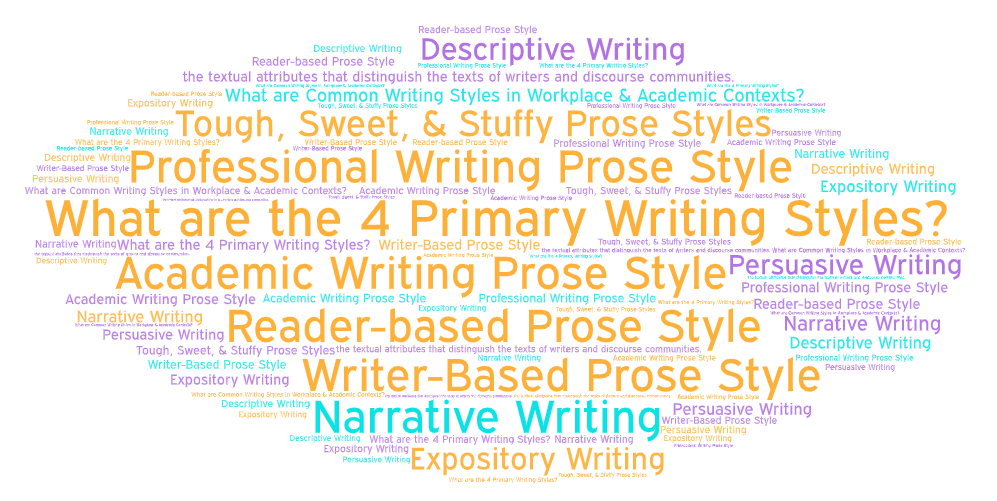
Writing Styles refers to
- For example, a writer may employ a narrative style , a descriptive style , an expository style , or a persuasive style . Writing styles vary according to the rhetorical situation. identified by noting the writer’s aim of discourse and by rhetorically analyzing the textual attributes that characterize a writer’s work or the works of a community of writers–such as engineering writing or medical writing.
- A corpus linguist might analyze a writer’s style by engaging in sentiment analysis : They could evaluate the writer’s s diction ; use of concrete, sensory language , metaphor , similie; and figurative language . Based on the writer’s word choice and other rhetorical devices , is the author positive, negative, neutral about the topic? Objective? Subjective? Overly emotional?

Synonymous Terms
Writing Styles may also be called
- Types of Writing, Types of Discourse
- Mode of Writing, Mode of Expression, Mode of Discourse
- Style of Expression
Related Concepts: Audience – Audience Awareness ; Genre ; Rhetorical Stance ; Persona ; Purpose ; Register ; The Elements of Style ; Tone ; Voice .
Guide to Writing Styles
In life, writers and speakers face innumerable exigencies–calls to write and speak . Each of those circumstances challenge writers (and speakers) to adopt a style of expression that the audience will deem appropriate and compelling. Thus, writers (and speakers) are likely to adopt many different writing styles during the course of their lives–and those types of writing change over time as societies and technologies evolve ( more ).
You can identify the s tyle of writing of your work or the work of others by engaging in rhetorical analysis of the text. Most notably, after reading and re-reading the work, analyze the work from a rhetorical, semantic, linguistic, and visual perspective:
- What is the aim of the discourse ? For instance, at the global level, is the intention of the writer to tell a story or to persuade the reader about something?
- Is the text audience sensitive?
- Does the writer or speaker consider the information literacy expectations of the target audience? For instance, if they are communicating in an academic context , does the author’s review of ongoing scholarly conversations about the topic demonstrate an awareness of the critical reading [practices of educated audiences? Does their text suggest they are careful to consider the accuracy , authority, context , currency , purpose , and relevance of information (e.g., textual research or empirical research)
- Does the author employ Standard Written English?
- What register does the author use? Formal or informal diction ?
- What information visualizations does the writer provide? Pictures ? Charts? Figures? Graphs? Tables ? Data visualizations? Infographics?
Style & Aims of Discourse
Writing styles are often identified by sorting texts by the aim of discourse . For example, in A Practical System of Rhetoric , a rhetoric textbook first published in 1827 and then used religiously by American students for about 60 years, Samuel P. Newman argues that people engage in communication to achieve four primary aims :
- to tell stories
- to describe ideas, events, and people
- to educate, to inform
- to persuade.
When writers and speakers compose texts to achieve these aims , they produce four different types of writing:
- Narrative Writing – Narration
- Descriptive Writing – Description
- Expository Writing- Exposition
- Persuasive Writing – Persuasion
Following Newman, generations of teachers have taught these aims of discourse in their classrooms.
- Rhetorical Modes
In the rhetorical tradition, narration , description , exposition , or persuasion may be known as
- Modes of Discourse
Yet the terms rhetorical mode or modes of discourse are typically reserved for instances when a part of a writer’s text is discussed as opposed to the whole text . For instance, writers and speakers may use description and narration to compose some paragraphs and sentences in a text yet when that text is viewed as a whole it may be judged to be persuasive or expository .
Aims of Discourse
Building on the shoulders of Samuel P. Newman’s work, James L. Kinneavy (1971) postulated there are four primary aims, or purposes, for communication :
What are Common Writing Styles?

Just as the primary colors (white, black, red, yellow, and blue) may be used to create a kaleidoscope of colors, so too can the primary writing styles be blended and remixed to create new styles.
Because life is complicated, writers may have many more reasons for communicating than suggested by the four primary writing styles. For instance, writers may compose documents to
Academic Writing Prose Style
Academic writing is often portrayed as a monolithic form of discourse. For instance, Ronald suggests “[m]any professors believe that you should be learning to write one certain kind of style in college, one that’s objective, impersonal, formal, explicit, and organized around assertions, claims, and reasons that illustrate or defend those claims” (Ronald 1999, p. 175).
In practice, however, academic writing may be more varied, more robust, and more open to stylistic play than these portrayals suggest. Thanks to new writing spaces such as Twitter, WordPress, YouTube, and Instagram, academic writers have new opportunities to express themselves–and the affordances of those technologies tend to favor the first person and individual expression. Additionally, at least in the humanities, use of the first person is becoming more commonplace .
Textual Attributes of Academic Writing
- Research-based
- Thoughtful, well reasoned, detailed
- Reflective, self-critical
- Formal in style and tone
- Thesis-driven & deductively organized
- Respectful of copyright and intellectual property
Recommended Resources
- First-Person Point of View
- Using First Person in an Academic Essay: When is It Okay?
- A Synthesis of Professor Perspectives on Using First and Third Person in Academic Writing
Professional Writing Prose Style
The writing styles of professional writers tend to vary across communities of practice . For instance, the writing style of a lawyer is quite different from that of an accountant or a mathematician. However, across work contexts , there are a number of textual attributes and rhetorical constraints that tend to characterize the texts of professional writers.
- Rhetorically Sensitive Professional writing is fundamentally transactional : usually if you are writing you are trying to solve some kind of a problem. Your audience — the people you are writing to — probably need to do something in response to your writing. They may not be expecting your writing. They probably don’t want to read your writing. Your writing is interrupting their day. So, if you’re gonna bother them you need to make it worth their time. Thus, professional writers tend to focus first and foremost on what they want the reader to think, feel, and do . The audience for professional writing tends to be coworkers, clients, employers. Typically in workplace contexts the audience is less informed about the topic than the writer. Often knowledge workers are endeavoring to simplify complex information to less informed audiences . They write from the persona of a subject matter expert, and their aim is to present information as simply as possible.
- adhere to the conventions of standard written and spoken English
- organize information deductively
- adopt universal design principles
- adhere to principles of brevity , flow , inclusivity , simplicity , and unity
- use extensive elements of visual language , such as photographs , data visualizations , and infographics
- To promote clarity and readability, professional writers are as concise as possible. They endeavor to strip away any unnecessary information .
- Professional writing tends to be truthful and evidence based . Readers and users of professional documents need to be confident that they can rely on the information being provided.
Writer vs. Reader Based Prose Style
In Writing Studies , Linda Flower (1979) proposed a categorization schema for discussing student writing that is wildly popular in the U.S among the writing studies community :
- Writer-Based Prose Style
- Reader-Based Prose Style
For Fowler, a reader-based prose style “creates a shared language and shared context between writer and reader ” whereas a writer-based prose style uses abbreviated, self-centered, informal, vague language—i.e., language that is personally meaningful to the writer but not the reader.
Tough, Sweet, Stuffy Prose Styles
For Walker Gibson, the universe of discourse “can be seen as an adjustment or compromise among these three styles of identifying ourselves and defining our relation with others”:
- The Tough Talker
- The Sweet Talker
- The Stuffy Talker.
How Can I Adopt an Appropriate Style?
You can determine the best writing style for a given rhetorical situation by engaging in the following composing strategies :
- Determine how formal you need to be by engaging in rhetorical analysis and rhetorical reasoning
- Companies often invest significantly in branding, and that branding includes guidelines for templates, logos, and images.
- Determine your perspective , point of view , persona , voice , tone
- use of Metaphor, Personification, Simile —these elements of figurative language can help your readers can better imagine and visualize your message
- Eliminate archaisms, biased language , clichés , jargon
- Be aware of the connotations of your words and idioms.
Related Concepts
Examples of research and theory on style.
Ray, Brian. (2015). Style: An Introduction to History, Theory, Research, and Pedagogy . Parlor Press; The WAC Clearinghouse. https://wac.colostate.edu/books/referenceguides/style/
Ronald, K. (1999). Style: The hidden agenda in composition classes. In W. Bishop (Ed.), The subject is writing: Essays by teachers and students (pp. 167- 82). Portsmouth, NH: Heinemann.
Related Articles:

Academic Writing - How to Write for the Academic Community

Edit for AWK (Awkward Writing)

Professional Writing - How to Write for the Professional World
Reader-based prose, substantive prose.

Tough, Sweet, & Stuffy Prose Styles
Writer-based prose, you-centered business style, suggested edits.
- Please select the purpose of your message. * - Corrections, Typos, or Edits Technical Support/Problems using the site Advertising with Writing Commons Copyright Issues I am contacting you about something else
- Your full name
- Your email address *
- Page URL needing edits *
- Email This field is for validation purposes and should be left unchanged.

- Joseph M. Moxley
Academic writing refers to the writing style that researchers, educators, and students use in scholarly publications and school assignments. An academic writing style refers to the semantic and textual features...

What does AWK Mean? Should you use AWK when critiquing the work of other writers, speakers, and knowledge workers? Learn how to edit awkward sentences.

- Joseph M. Moxley , Julie Staggers
Professional writing is fundamentally transactional: usually if you are writing it is because you are trying to solve some kind of a problem. Your audience — the people you are writing to...

Learn about Walter Gibson’s model of tough, sweet, or stuffy prose styles. Learn to work on your voice, tone, and persona in prose.
- Angela Eward-Mangione
Featured Articles

Academic Writing – How to Write for the Academic Community

Professional Writing – How to Write for the Professional World

Authority – How to Establish Credibility in Speech & Writing

8 Different Types of Writing Styles (And How to Improve Your Own)
Sometimes, the best way to explain something is by writing a story, and sometimes, the best way to convince someone about your idea is by stating the facts.
Sometimes, we take readers on a grand journey with our write-up, and sometimes, we just relay some basic information in a short and sweet paragraph.
There are so many styles of writing out there and if you really want to master the art of writing, you first need to learn these styles and pick one to get your message across.
In this blog, we will walk you through eight different types of writing styles and some tips that will help you improve your writing prowess. Ready? Let’s go.
List Of Eight Different Types Of Writing Styles
1. descriptive writing.
People often assume that descriptive writing is about using fancy and flowery phrases. However, strong descriptive writing is much more than that.
Descriptive writing provides details about things such as an event, a setting, or a group of characters. More often than not, these writings are personal, short, and subjective.
The main goal of descriptive writing is to make the readers feel like they’re experiencing everything in the storyline themselves. For that, you need to provide a vivid image of the story to the readers.
You can use this writing style to set the scene and add some spice to your writing. However, make sure that you don’t end up overusing it.
2. Persuasive Writing
Let’s say you want to write a book about the significance of eating green vegetables. One way to convince people to adopt this idea is by using a persuasive writing style .
Persuasive writing is used to convince the readers to believe in an idea (and implement it). This writing style is grounded in logical reasoning and works well for appealing to the reader on an emotional level.
This writing style is usually used in advertisements, reviews, recommendation letters, cover letters, company brochures, business proposals, and opinion columns.
You can also use it to gain support for a noble cause, such as using environmental-friendly products or updating obsolete company policies.

Read more: Proposal Writing: Everything You Need to Know!
3. Narrative Writing
It is very easy to bore a reader with facts, figures, and examples that they can’t relate to. That’s where narrative writing comes in. You might find it in novels, biographies, poems, memoirs, and more.
Narrative writing is all about stories, connecting facts, teaching without explaining, and helping readers relate to the content. It often has a very clear beginning, middle, and end.
Occasionally, writers also use flashbacks and foreshadowing as tools to engage with the audience, while some even use characters and dialogues to tell the story.
All in all, narrative writing is great for keeping the audience hooked till the end. After all, we all love stories and we’re hard-wired to pay attention to them.
4. Expository Writing
Expository writing gives the readers important information and instructions about a topic. It’s entirely based on facts and doesn’t include a writer’s personal opinions on the subject.
You can find this writing style in textbooks, newsletters, educational articles, business/technical/scientific writing, recipes, newsletters, and more.
As expository writing is all about facts and figures, it does not always make the best hook. However, as they say, there are exceptions to every rule.
For instance, if you begin your write-up with a shocking stat , it is bound to grab a reader’s attention. You can even use it along with persuasive and narrative writing, adding the power of logic to your stories.
5. Review Writing
This writing style aids the reader in deciding whether they should invest in a product/experience or not. It involves both subjective and objective thoughts in order to relay the authors’ experience.
Review writing doesn’t always include persuasive writing, as the reader might or might not recommend the subject matter for both factual and personal reasons.
Reviews could be about anything – be it books, food, movies, video games, theme park experiences, toys, restaurants, places, or even a movie character.
However, no matter what you’re reviewing, make sure that you describe the physical flaws (example: low-quality plastic), perks (example: easy to set up), and experiential opinions (example: a breathtaking view).
6. Technical Writing
Most of us don’t have the time to scour highly technical and scientific writings (instructional manuals, white papers, scientific papers) to get the information that we need.
Well, technical writing is here to save the day! It takes complex technical and scientific content – and simplifies it for the average reader. The purpose is to communicate knowledge and instructions in the easiest way possible.
You can use technical writing to educate your employees on how to conduct safety procedures, or to break down the research data into accessible text.
You can also use this writing style to teach consumers how to assemble a product, or to explain the complex product features to them. The use-cases are endless!
7. Objective Writing
The word ‘objective’ describes something that’s purely factual and not influenced by personal feelings. So, objective writing is something that can be verified through facts and evidence.
In objective writing , the author is supposed to remain neutral and unbiased and let the readers form their own opinions. In short, objective writing means sticking to facts instead of opinions.
This writing style tends to lack vagueness and is very to-the-point. For example, rather than ‘almost everyone voted for her’, it will be ‘83% of the residents voted for her’.
Another important thing that you need to keep in mind here is: try not to over-exaggerate your writing. Don’t use words like ‘always’, ‘never’, ‘really’, or ‘very’. They can make your writing appear weak.
8. Subjective Writing
Subjective writing is opinion-driven writing . It expresses feelings, opinions, beliefs, perspectives, and judgments – and lacks factual statements and evidence. Hence, it can’t be verified.
Subjective writing originates from the personal experience and observation of the writer, and it gives the reader an insight into the author’s thinking process.
This writing style often makes the readers feel like someone’s speaking to them personally. The words “I’, “you”, “us’, and “we are added throughout each line.
You can find subjective writing in personal journals, blogs, speeches during informal events, literary work such as poems and stories, social media posts, and more.
Now, let’s learn a few tips you can follow to improve your writing style and make sure that you’re sending a clear (and accurate) message that the readers can comprehend.
Read more: 9 Powerful Tips For Writing Great Content For Your Website!
5 Solid Tips To Improve Your Writing Style
1. be direct.
Do you know what are the two key aspects of good writing ? Clarity and conciseness. Filler words, prepositional phrases, unnecessary adverbs…they simply take up space and weigh down the sentence.
So, a good rule of thumb is to say exactly what you mean in a direct, straightforward way. This will make it super easy for readers to engage with your ideas or your stories.
2. Use a Conversational Tone
Always write like a human, not a robot. Express the ideas with your own unique voice and try to avoid clichés. Your writing style should always reflect your personality.
Use the same tone that you do when you’re speaking, and modify it a little according to what you’re writing. This means, use simple sentences, easy structures, and natural phrases that a reader can easily grasp.
3. Choose Your Words Wisely
There’s an assumption that rich vocabulary makes you a better writer , but it couldn’t be further from the truth. You should choose words and vocabulary that are appropriate for your audience.
Always remember that you’re writing for people, and if someone needs to look up the meaning of a word before they read further, you are very likely to lose them.
4. Avoid Using Passive Voice
Every writer has heard this advice – use active voice and stick to the good old subject-verb-object structure. Why? Because passive voice creates complex sentences and is not a good way of delivering information.
Moreover, in active voice, the subject is doing something. This is certainly more appealing than the passive voice, where something is being done to the subject.
5. Keep Your Sentences Short
A wonderful way to make your writing better is by limiting the use of long sentences. Short sentences are way easier to understand – something that readers always appreciate!
So, avoid packing too much information into one line and make sure that every sentence conveys one thought or idea. The easiest approach is to break up a long sentence into two or more short sentences.
Wrapping Up
Having a clear understanding of all the different types of writing styles is essential. After all, the way you write expresses who you are and what message you are trying to put across.
Each writing style has its time and place, so make sure that you learn the nitty-gritty of all the writing styles before using them. Knowing when and how to implement a writing style can raise the value of your work.
Do you have a preferred writing style? Or is there any writing style that we missed out on? Let us know by tweeting us @bit_docs. We would be happy to hear from you. Good luck!
This blog has been written by the Bit.ai team. Bit.ai is a powerful, new-age document collaboration platform where you and your team can easily create, access, share, and manage all your documents. To learn more about this amazing platform, visit Bit.ai .
Further reads:
Top 9 Writing Checkers Every Writer Should Use!
11 Grammarly Alternatives and Competitors You Must Know!
9 Awesome Assignment Writing Tips to Get Better Marks!
9 Essential Writing Tips Every Writer Must Use!
10 Writing Tools that are Essential for a Writer!
Report Writing: Steps, Tips & Tools!

9 Best Campaign Management Tools & Software in 2023
13 Growth Marketing Strategies You Must Know About!
Related posts
How chatgpt can help you create content a quick overview, how to embed smartsheet spreadsheets to your documents, team plan: what is it & how to create it, mitigation plan: what is it & how to create one, 17 marketing terms you must be aware of, what’s the best way to create an internal wiki.

About Bit.ai
Bit.ai is the essential next-gen workplace and document collaboration platform. that helps teams share knowledge by connecting any type of digital content. With this intuitive, cloud-based solution, anyone can work visually and collaborate in real-time while creating internal notes, team projects, knowledge bases, client-facing content, and more.
The smartest online Google Docs and Word alternative, Bit.ai is used in over 100 countries by professionals everywhere, from IT teams creating internal documentation and knowledge bases, to sales and marketing teams sharing client materials and client portals.
👉👉Click Here to Check out Bit.ai.
Recent Posts
Maximizing digital agency success: 4 ways to leverage client portals, how to create wikis for employee onboarding & training, what is support documentation: key insights and types, how to create a smart company wiki | a guide by bit.ai, 9 must-have internal communication software in 2024, 21 business productivity tools to enhance work efficiency.
- Scriptwriting
Different Types of Writing Styles — Forms of Writing Explained
W hat are the different styles of writing? How many different types of writing styles and forms of writing are there? There is some disagreement of how many major forms of writing there are. Depending on which source you turn to, you might be told there are only four different styles of writing or you might be told there are as many as 12 forms of writing. There is no right or wrong answer to this question as the matter is subjective, but four is the most commonly accepted answer. In this post, we will be breaking down ‘the 4 types of writing’ and, along the way, we’ll explain the ways that some choose to further subdivide those forms of writing. Let’s get started by defining the first of our major forms of writing.
What are the different types of writing formats?
1. narrative.
What are the types of writing? • An introduction to narrative writing
If you are a screenwriter (or wish to become a screenwriter ), then this is the writing type most applicable to you. Simply put, narrative writing is storytelling. Narrative writing often falls under the fiction side of the fiction/non-fiction divide and tells a story with character arcs , a plot , and a structure , but narrative writing can also exist in other kinds of writing like structured non-fiction such as a biography that tells someone’s life story.
Narrative writing encompasses prose, screenwriting, and certain types of poetry . Some sources suggest that creative writing should be classified as its own type outside of narrative writing. Check out our collection of creative writing prompts .
Different types of writing genres
2. descriptive.
What types of writing are there? • Intro to descriptive writing
Descriptive writing does as the name implies; it describes. Much of descriptive writing is sensory and revolves around sights, sounds, scents, tastes, and feelings. Descriptive writing is often powered by adjectives but is by no means limited to adjectives alone.
The ultimate goal of descriptive writing is to conjure a clear mental image for the reader. Descriptive writing is frequently found in poetry and in prose, but can also be incorporated into most other forms of writing as well, such as in persuasive writing if the goal is to describe or review something; like describing the taste and scent of food in a restaurant review.
Different styles of writing
3. persuasive.
What are the different types of writing formats? • A lesson on persuasive essays
The goal of persuasive writing is to convince the reader of a particular stance on a subject. Persuasive writing is often presented in the form of an essay or video essay but may also occur in other forms such as in a highly thematic book or film with a central message it is trying to get across. Persuasive writing is also heavily used in the advertising world to persuade consumers to purchase a product. Persuasive writing also encompasses things like reviews, though some sources suggest that review writing should be classified as its own type.
4 types of writing
4. expository.
The different types of writing genres • A lesson in expository writing
Expository writing is the presentation of bonafide information. Expository writing is not the same as exposition in a story , though it does function in a similar way to convey information. There is no opinion or subjective perspective involved in expository writing.
All information included in expository writing should be verifiable through authoritative sources. Expository writing is often found in textbooks, instruction manuals, journalism, and technical writing. Expository writing may be used in support of persuasive writing.
What are the types of writing?
Other classifications.
What types of writing are there? • The four forms of writing
Aside from the four main kinds of writing we’ve defined above and the additional subclassifications others use that we’ve mentioned, there are alternative ways to separate different styles of writing based upon different criteria. If you wish to create a simple, binary division, you could divide all writing into either fiction or non-fiction.
Another binary divide could classify writing as either objective or subjective. Writing can also be distinguished by medium: prose, poetry, stage play, screenplay , teleplay , essay, etc.
How to Write Every Day
Now that you have a thorough grasp of the different styles of writing, it’s the perfect time to develop your overall writing skills. No matter which type of writing you specialize in, developing better writing habits will always lead to improvement. Up next, learn tactics and tricks to help you write every day.
Up Next: How to Write Daily →
Showcase your vision with elegant shot lists and storyboards..
Create robust and customizable shot lists. Upload images to make storyboards and slideshows.
Learn More ➜
Leave a comment
Your email address will not be published. Required fields are marked *
- Pricing & Plans
- Product Updates
- Featured On
- StudioBinder Partners
- The Ultimate Guide to Call Sheets (with FREE Call Sheet Template)
- How to Break Down a Script (with FREE Script Breakdown Sheet)
- The Only Shot List Template You Need — with Free Download
- Managing Your Film Budget Cashflow & PO Log (Free Template)
- A Better Film Crew List Template Booking Sheet
- Best Storyboard Softwares (with free Storyboard Templates)
- Movie Magic Scheduling
- Gorilla Software
- Storyboard That
A visual medium requires visual methods. Master the art of visual storytelling with our FREE video series on directing and filmmaking techniques.
We’re in a golden age of TV writing and development. More and more people are flocking to the small screen to find daily entertainment. So how can you break put from the pack and get your idea onto the small screen? We’re here to help.
- Making It: From Pre-Production to Screen
- What is a Light Meter — Understanding the Photographer's Tool
- What is Metonymy — Definition, Examples & How to Use It
- What is a Short Story — The Art of Brevity in Literature
- What is an Action Hero — Best Examples & Defining Traits
- What is a Movie Spoiler — Types, Ethics & Rules Explained
- 3 Pinterest
- Words with Friends Cheat
- Wordle Solver
- Word Unscrambler
- Scrabble Dictionary
- Anagram Solver
- Wordscapes Answers
Make Our Dictionary Yours
Sign up for our weekly newsletters and get:
- Grammar and writing tips
- Fun language articles
- #WordOfTheDay and quizzes
By signing in, you agree to our Terms and Conditions and Privacy Policy .
We'll see you in your inbox soon.
4 Fundamental Types of Writing Styles (With Examples)
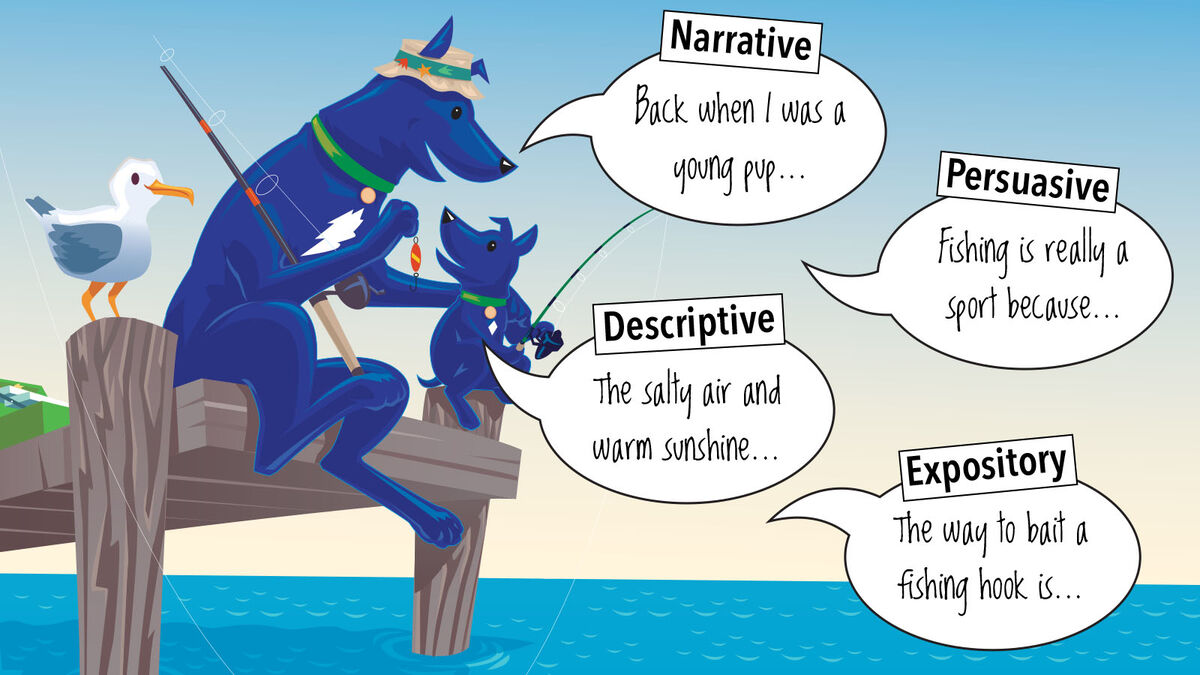
- DESCRIPTION narrative, descriptive, persuasive, expository writing styles
- SOURCE Dynamic Graphics / Dynamic Graphics Group / Getty Images Plus
Depending on your purpose, you’ll want to use one of the four main types of writing styles: descriptive, expository, narrative, and persuasive. Each style has its own purpose, and you may find some styles are more natural for you than others. These writing style examples and tips will help you become a pro at all four.
What Are the Different Styles of Writing?
There are four main types of writing styles. Each has a distinct purpose.
- expository - Write in this style to explain or expose a topic.
- narrative - Write in this style to tell a story.
- persuasive - Write in this style to convince the reader of something.
- descriptive - Write in this style to create an image in the reader’s mind.
The key to knowing when and how to use these styles is mostly about being aware of what you want to convey to your reader.
Expository Writing: Explain or Expose
When you want to convey information to your reader or help the audience better understand something, use expository writing. There are several types of expository writing, including compare and contrast, cause and effect, and analysis, among others.
Types of Expository Writing
There are several kinds of expository writing. In every type of expository writing, the style is all about converting facts with clarity and focus. In great expository writing, nothing is confusing or unclear.
- business writing
- expository essays
- how-to/instructional articles
- news writing/journalism
- scientific reports
- technical writing
Expository Writing Examples
Great news reporting is expository in nature, as is writing that is focused on providing instruction or education. It tells the facts and explains details the reader needs to understand those facts. Even better, it exposes or “sheds light on” things the reader needs to know. A great example is the Watergate reporting done by Bob Woodward and Carl Bernstein in 1972 for The Washington Post . Notice how the reporters add detail and background information while keeping the article on-topic in this Pulitzer prize-winning example :
"President Nixon's assistant for congressional relations and two officials of the President’s re-election committee were among the persons sent memos describing wire-upped conversations of Democratic Party officials, according to Alfred C. Baldwin III. Baldwin, the ex-FBI agent who says he transcribed the wiretapped conversations of Democratic officials in the Watergate, is known to have told the FBI that memos summarizing some of the conversations were addressed to the following persons, among others ..."
For more insights, consider these brief examples of expository writing:
- The resolution passed by a significant majority, with all but two of the 15 committee members voting in favor of it. The new rules will be effective as of June 1, 2022. Details about enforcement are expected to be released next week.
- The most common relative adverbs are where, when and why. To choose the correct one, decide if you need to provide information on location (where), time (when) or reason (why).
- To grow your own plants, you'll need seeds, potting soil, a small container, and water. Fill the container with potting soil. Use your finger to create a few small holes. Place one seed in each hole, then lightly cover with soil. Lightly water the soil and place in a sunny location. Water every few days.
Tips for Writing in an Expository Style
When you use this writing style, it's important to keep in mind your purpose: you are writing to explain and illuminate. Don't add your own opinion or make anything up.
- Choose a topic and narrow your focus.
- Create a thesis statement or main idea.
- Only include information that directly relates to your topic or provides necessary background context.
- Consider what your reader knows about your topic and decide what you need to explain.
- Include facts and concrete details. Connect these back to your main idea with clear statements.
Narrative Writing: Tell a Story
Narrative writing tells a story, real or fictional. Whether or not the events described really happened, this type of writing is all about presenting the story in a way that readers will enjoy and understand. The events don’t have to happen in chronological order, but they must capture and hold the reader’s attention.
Types of Narrative Writing
Narrative writing can take many forms. It can be your own story, such as a memoir or a personal essay . It can also be the story of a historical event or a work of fiction, such as a short story or novel.
- oral history
- short stories
Narrative Writing Example
In this type of writing, the goal is to tell the reader what happens in a way that is compelling. This can involve creating characters and describing settings in a way that makes the story more realistic. However, while descriptive details are part of narrative writing, this type of writing is not solely about description. This is about what happens in the story. You can see this in action in this example from Oliver Twist by Charles Dickens.
"Not having a very clearly defined notion of what a live board was, Oliver was rather astounded by this intelligence, and was not quite certain whether he ought to laugh or cry. He had no time to think about the matter, however; for Mr. Bumble gave him a tap on the head to wake him up, and another on the back to make him lively, and bidding him follow, conducted him into a large whitewashed room where eight or ten fat gentlemen were sitting round a table, at the top of which, seated in an armchair rather higher than the rest, was a particularly fat gentleman with a very round, red face."
Consider a few original examples of narrative writing.
- Seeing eight missed calls from her nephew first thing in the morning filled her with dread. Surely she knew what he wanted to tell her. The moment in time that they had been dreading for so long had finally come to pass. She dialed even though she knew what he was going to say. "It's done," he said. She replied, "I know."
- She checked her email, hoping against hope to receive some positive news about her job search. She noticed a message in her inbox from a company she applied to work with. Good news or bad news? She wasn't sure. But there was only one way to find out. With hope and trepidation, she clicked the message.
- The little dog looked suspiciously at the dog door. She had never seen such a thing. Being a shelter rescue she was accustomed only to the bars of a crate, with a door fully opened or fully closed, with no ability to move about freely. The pup pushed the flap gently with her nose but did not know what to do.
Tips for Writing in the Narrative Style
If you’re writing a narrative, keep in mind that you are telling a story. Include details and information that will keep your reader engaged.
- Include all the pieces of the story. How did it start? What happened to make it exciting? How did it end?
- Know why you’re telling the story. Even though the story is the purpose, keep your reason for telling it in mind.
- Keep the point of view consistent throughout the story.
- Stick to the story. Avoid extraneous details that will distract the reader.
Persuasive Writing: Convince the Reader
Persuasive writing is unique because it has a very clear and important purpose: convincing the reader to do something or think something. To succeed at this type of writing, you need a clear goal. Know what you want the reader to do or believe after reading your work.
Types of Persuasive Writing
Any writing designed to sell readers on something is an example of persuasive writing . It can take many forms.
- advertisements
- business proposals
- college admissions essays
- cover letters
- elevator pitches
- letters of recommendation
- opinion/editorial articles
- product reviews
- sales pitches
Persuasive Writing Example
Persuasive writing is only successful if you are clear about your goal and then support that goal with relevant points. This builds a case for your reader. You can see this type of writing in action in this excerpt from the Declaration of Independence .
"The history of the present King of Great Britain is a history of repeated injuries and usurpations, all having in direct object the establishment of an absolute Tyranny over these States. To prove this, let Facts be submitted to a candid world. He has refused his Assent to Laws, the most wholesome and necessary for the public good. He has forbidden his Governors to pass Laws of immediate and pressing importance, unless suspended in their operation till his Assent should be obtained; and when so suspended, he has utterly neglected to attend to them ..."
Review a few more modern examples of persuasive writing.
- Are you ready to grow in your career? Is your lack of skill working with modern technology holding you back? Register today for the Computer Tech training program and master the applications you need to know to attain the career of your dreams.
- Do you love the great outdoors? Did you choose to live here because of the proximity to lakes, rivers and white sand beaches? Are you concerned with protecting the natural beauty of the local environment? Show your commitment by joining Environment Now today.
- My background makes me uniquely suited for the position you are seeking to fill. Not only do I have experience teaching Interpersonal Communication classes, but I also have direct experience teaching this course via the same online platform your institution uses.
Tips for Writing in the Persuasive Style
Whether you’re writing a persuasive essay or creating a speech, this type of writing requires a clear purpose and good organization.
- Select an angle that will help you accomplish your goal.
- Decide what will help convince the reader that your goal should also be their goal.
- Research supporting details.
- Adjust the tone of your writing to appeal to the reader. Aristotle’s methods of persuasion can help. Know whether you’re appealing to emotion, logic, or ethics.
- End with a clear call to action. Tell the reader what to do next.
Descriptive Writing: Form a Picture for the Reader
This type of writing is about sharing perspective. In effective descriptive writing, you create a picture in the reader’s mind using your descriptions. Often, this type of writing includes vivid imagery and involves many of the five senses.
Types of Descriptive Writing
Descriptive writing can be fiction or nonfiction. It often uses figurative language , but also provides concrete information. There are many types of descriptive writing.
- first-person accounts
- freewriting
- journal writing
- product descriptions
- reflective writing
- statement of teaching philosophy
- travel writing
Descriptive Writing Example
An example of descriptive text can help you understand how this type of writing works. Bringing in sensory details can create a much more vivid picture for the reader, as you can see in this example from Dinner at the Homesick Restaurant by Anne Tyler. In the space of two short paragraphs, she uses descriptive sensory details from four of the five senses.
"The car drew in around them like a room. Their breaths fogged the windows. Earlier the air conditioner had been running and now some artificial chill remained, quickly turning dank, carrying with it the smell of mildew. They shot through an underpass. The rain stopped completely for one blank, startling second. Sarah gave a little gasp of relief, but even before it was uttered, the hammering on the roof resumed. She turned and gazed back longingly at the underpass. Macon sped ahead, with his hands relaxed on the wheel."
Peruse a few brief examples of descriptive writing.
- When she entered the house, she observed what seemed to be a spotless environment. The counters were clear and the floors were spotless. The furniture was perfectly aligned. Not a single thing was out of place and she could smell bleach in the air.
- The hiking trail appeared very well kept. The gravel trail was even, with no accumulation of leaves or debris. Trees lined both sides of the trail. She could make out the river just to the east of the trees.
- Traffic on the interstate seemed heavier than usual. There was a line of cars filling both lanes ahead as far as the eye could see. There were cars behind her vehicle as well, stretching out as far as was visible. Traffic was moving steadily, though below the speed limit.
Tips for Writing in the Descriptive Style
When you use this style of writing, you are creating an image for your reader. Don’t include details that distract the reader from the image you are creating.
- Before you begin your description, imagine you're in the scene. Consider what you experience with your senses.
- Use sensory descriptions instead of adverbs as much as possible.
- This writing style requires thought, so take your time.
- Focus on details that are important to the story.
Each Type of Writing Style Has a Purpose
Each of the four main types of writing styles has a different purpose. Keep that purpose in mind when you choose the style for your writing. Then, consider closely related elements like examples of tone and examples of mood to help convey your message to readers in an appropriate manner. Vary the literary devices you use, adjusting as needed for different types of writing.
Types of Writing (Styles, Examples, 13 Key Tones)

Writing eloquently is more than simply mastering proper grammar . It means being comfortable with writing in different styles. The writing style denotes the way in which a writer arranges the words and expresses their thoughts. This also affects how the readers understand a text. The writing style is determined by factors like the topic of discussion and the intended audience.

The different types of writing include the following
Narrative writing.
This form of writing is used to express the imagination of the writer. It is used in both fiction, as well as non-fiction. The author, rather than simply stating rote facts, weaves a beautiful story using the information. It is usually used in narrative journalism, autobiographies, biographies, novels, and short stories.
Descriptive writing
This style of writing is used by authors to paint a picture for the reader about the product or place or anything else they are writing about. Writers can use first-person, second-person, or third-person POV in this style. Literary devices like simile and metaphor are widely used in this style.
Persuasive writing
This style of writing is used in academic or business settings. The author uses this style to convince the reader of an idea or proposal. Reasons, justifications, and conclusive proof are also extensively used in this style to provide credibility to the paper or document.
Expository writing
Expository writing concentrates on researching a specific topic and presenting the facts. In this style, the authors will examine a topic in-depth and develop it using facts and evidence. The authors do not try to convince the reader about anything, as seen in the persuasive style. Rather, the author presents the information and lets the reader make inferences.
Business writing
This style is used by authors to convey a notion or an idea for internal use and occasionally for use by the public. Usually, the style used by the writer is in accordance with the company guide. The writers take notes about company policies from higher-level managers or executives and convert them into business plans for the entire team. This style is also used while creating company manifestos, presentations, or pitch decks.
Technical writing
This style of writing is used to explain some complex topics to a general audience. The complexity of the style typically depends on the expertise level of the readers. The writer needs to have a high level of subject knowledge to successfully use this style.
Scientific writing
This style is usually used for writing grant proposals, peer-reviewed articles, and literature reviews. The author provides evidence as well as citations to support their claims in the documents. Objectivity, accuracy, and precision are the defining features of this style of writing.
Content writing
This style encompasses a wide variety of writing, including writing articles, blog posts, guides, and e-books. Content writing also focuses on producing SEO-optimized or keyword-enriched articles in a number of niches. This kind of writing is generally done to increase the traffic to a website organically.
Copywriting
Copywriting is the practice of playing with words to persuade a target market to purchase the goods and services of a company. Copywriting can be used to create copy for email funnels, websites, and sales pages. It is similar to content writing, but the copy should be more engaging and to the point. They should also always have a sales angle.
Critical writing
This style of writing is a subjective form of writing and is presented from the author’s perspective. Film reviews are a common form of critical writing. In this, the reviewer watches a movie and provides an analysis of it for the general public.
Diary writing
This form of writing is extremely personal and very rarely shared with the outside world. A writer keeps a journal to record happenings in their life as well as emotions. Many authors also use this as a way to vent their emotions. Diary writing can also be used to cope with negative emotions such as remorse, regret, fear, jealousy, grief, and sadness. The diaries of many famous people, like Anne Frank, have been published, inspiring millions of people worldwide.
Travel writing
Travel writers describe their experiences when exploring a location for their readers. It also celebrates the customs and traditions of different places around the world. Travel writing is aimed at helping readers understand different locations and the people living there . It will also help readers plan their trip to the said location. Travel memoirs, travel guidebooks, and nature writing are all part of travel literature.
In this type of writing, the authors usually focus on a particular niche they like, especially something a wider audience will love to read about. Blogs are written in electronic media, and this style of writing usually involves keyword research and SEO optimization.
Poetry writing
In this style of writing, the author or poet uses words to create imagery in the minds of people. The goal of most poems is to evoke some form of emotional response from the reader. This is a form of creative writing that uses literary devices like simile and metaphor. Poetry can be either freeform without any formal structure, or highly structured, adhering to the rules of meter and rhythm.
Is content writing and copywriting the same?
Content writing and copywriting are similar but slightly different. Content writing is used to describe a product or give information about something, whereas copywriting is focused on pitching a product to the customers. Content writing is focused on giving general information about the product, whereas copywriting is more focused on the sales angle.
How do authors choose the best writing style for any document?
The authors first consider the style guide provided by the publication agency. The target audience is also considered when choosing the writing style. The authors should also consider how the document might educate, inform, motivate, or amuse readers.
How can writing styles be improved?
An author can improve their writing style by:
- understanding the concept
- using straightforward words
- writing short paragraphs
- ditching adverbs
- avoiding fillers
- occasionally using qualifiers
- proofreading
- practicing writing relentlessly.
- Merriam-Webster – writing definition
- Research.com – A Guide to the Different Types of Writing
- Become a writer today – 13 Types Of Writing Every Writer Should Master
- OpenOregon – TYPES OF WRITING STYLES
Inside this article
Fact checked: Content is rigorously reviewed by a team of qualified and experienced fact checkers. Fact checkers review articles for factual accuracy, relevance, and timeliness. Learn more.

About the author
Dalia Y.: Dalia is an English Major and linguistics expert with an additional degree in Psychology. Dalia has featured articles on Forbes, Inc, Fast Company, Grammarly, and many more. She covers English, ESL, and all things grammar on GrammarBrain.
Core lessons
- Abstract Noun
- Accusative Case
- Active Sentence
- Alliteration
- Adjective Clause
- Adjective Phrase
- Adverbial Clause
- Appositive Phrase
- Body Paragraph
- Compound Adjective
- Complex Sentence
- Compound Words
- Compound Predicate
- Common Noun
- Comparative Adjective
- Comparative and Superlative
- Compound Noun
- Compound Subject
- Compound Sentence
- Copular Verb
- Collective Noun
- Colloquialism
- Conciseness
- Conditional
- Concrete Noun
- Conjunction
- Conjugation
- Conditional Sentence
- Comma Splice
- Correlative Conjunction
- Coordinating Conjunction
- Coordinate Adjective
- Cumulative Adjective
- Dative Case
- Declarative Statement
- Direct Object Pronoun
- Direct Object
- Dangling Modifier
- Demonstrative Pronoun
- Demonstrative Adjective
- Direct Characterization
- Definite Article
- Doublespeak
- Equivocation Fallacy
- Future Perfect Progressive
- Future Simple
- Future Perfect Continuous
- Future Perfect
- First Conditional
- Gerund Phrase
- Genitive Case
- Helping Verb
- Irregular Adjective
- Irregular Verb
- Imperative Sentence
- Indefinite Article
- Intransitive Verb
- Introductory Phrase
- Indefinite Pronoun
- Indirect Characterization
- Interrogative Sentence
- Intensive Pronoun
- Inanimate Object
- Indefinite Tense
- Infinitive Phrase
- Interjection
- Intensifier
- Indicative Mood
- Juxtaposition
- Linking Verb
- Misplaced Modifier
- Nominative Case
- Noun Adjective
- Object Pronoun
- Object Complement
- Order of Adjectives
- Parallelism
- Prepositional Phrase
- Past Simple Tense
- Past Continuous Tense
- Past Perfect Tense
- Past Progressive Tense
- Present Simple Tense
- Present Perfect Tense
- Personal Pronoun
- Personification
- Persuasive Writing
- Parallel Structure
- Phrasal Verb
- Predicate Adjective
- Predicate Nominative
- Phonetic Language
- Plural Noun
- Punctuation
- Punctuation Marks
- Preposition
- Preposition of Place
- Parts of Speech
- Possessive Adjective
- Possessive Determiner
- Possessive Case
- Possessive Noun
- Proper Adjective
- Proper Noun
- Present Participle
- Quotation Marks
- Relative Pronoun
- Reflexive Pronoun
- Reciprocal Pronoun
- Subordinating Conjunction
- Simple Future Tense
- Stative Verb
- Subjunctive
- Subject Complement
- Subject of a Sentence
- Sentence Variety
- Second Conditional
- Superlative Adjective
- Slash Symbol
- Topic Sentence
- Types of Nouns
- Types of Sentences
- Uncountable Noun
- Vowels and Consonants
Popular lessons

Stay awhile. Your weekly dose of grammar and English fun.

The world's best online resource for learning English. Understand words, phrases, slang terms, and all other variations of the English language.
- Abbreviations
- Editorial Policy

- Future Students
- Parents and Families
The Graduate Writing Center
Helping uri graduate students' continued development of writing skills.
- What to Expect
- In-Person Consultations
- Online Consultations
- Workshops and Programs
- Writing Groups
- Schedule an Appointment
- Events & Announcements
- URI Resources
- Science Writing at URI
- Job Materials Help
- Additional Resources
- Consultant Testimonials
- Student Testimonials
- Schedule a Class Visit
- GWC Reports
Writing Styles
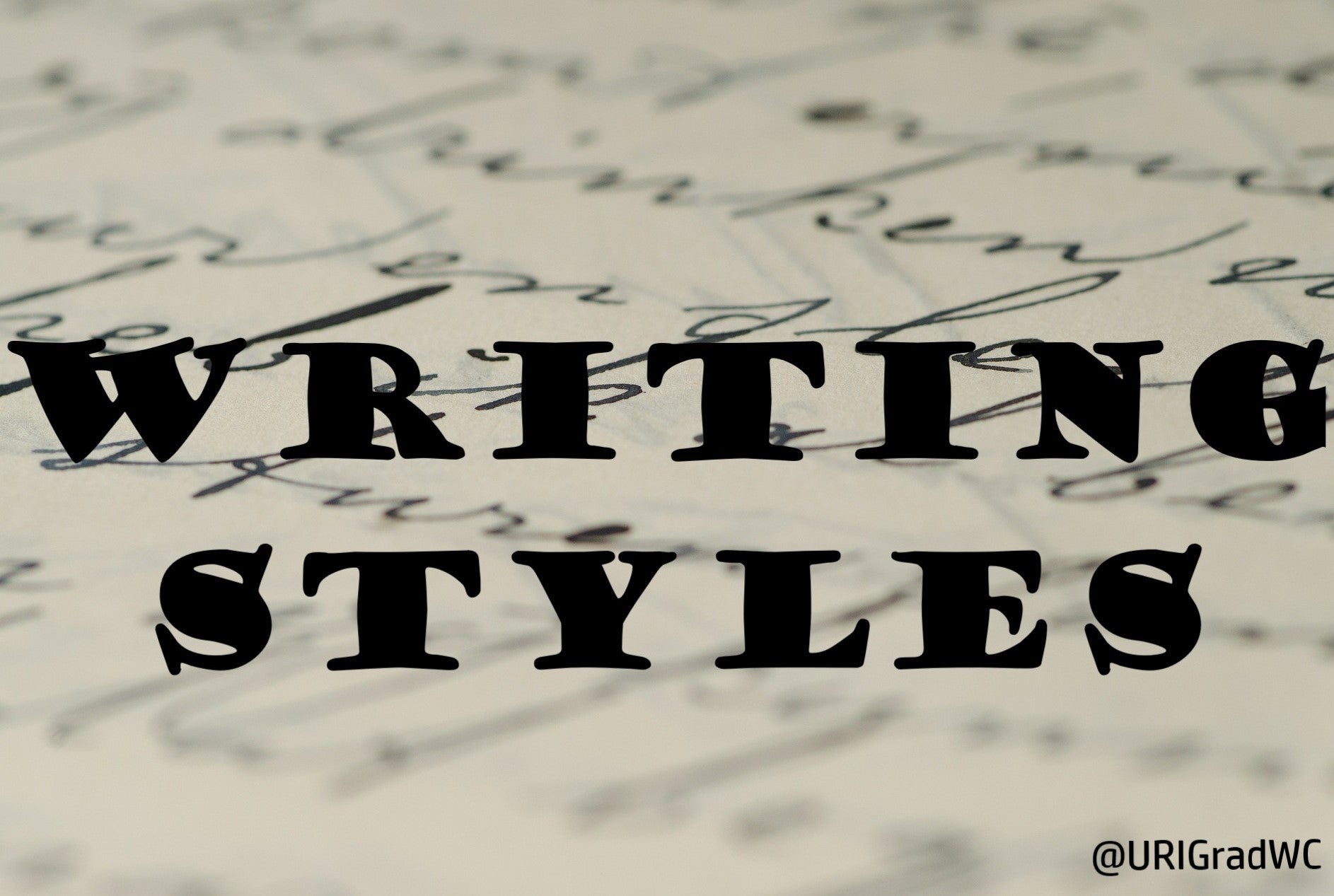
Your audience and writing purpose will determine your writing style. The four main types of writing styles are persuasive, narrative, expository, and descriptive. In this blog post, we’ll briefly explore the defining features of these four writing styles. For more help using these writing styles, schedule an appointment at the GWC!
Persuasive: For this writing style, the writer is trying to convince the reader of the validity of a certain position or argument. Persuasive writing includes the writers’ opinions, and provides justifications and evidence to support their claims.
Examples: Letters of recommendation; cover letters; Op-Eds and Editorial newspaper articles; argumentative essays for academic papers
Narrative: Often seen in longer writing samples, the purpose of this writing style is to share information in the context of a story. Narratives should include characters, conflicts, and settings.
Examples: Short stories; novels; poetry; historical accounts
Expository: This type of writing is used to explain a concept and share information to a broader audience. Expository writing provides evidence, statistics, or results and focuses on the facts of a certain topic. This type is not meant to express opinions.
Examples: How-to articles; textbooks; news stories (not editorials or Op-Eds); business, technical, or scientific writing
Descriptive: This type of writing is used to depict imagery to create a clear picture in the mind of the reader. This method helps the readers become more connected to the writing by appealing to their senses. Descriptive writing employs literary techniques such as similes, metaphors, allegory, etc to engage the audience.
Examples: Poetry; fictional novels or plays; memoirs or first-hand accounts of events
*This post was adapted from “Types of Writing Styles” by Robin Jeffrey.
Blog post prepared by Danielle Perry, GWC tutor. Published January 27, 2020.
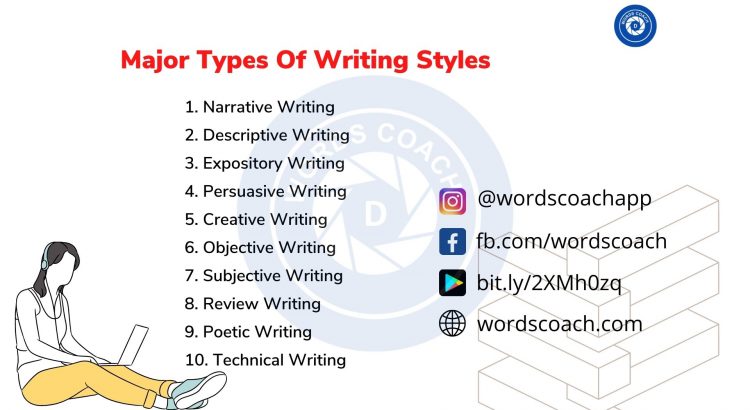
Major Types Of Writing Styles
The 10 main types of writing styles are Narrative Writing, Descriptive Writing, Expository Writing, Persuasive Writing, Creative Writing, Objective Writing, Subjective Writing, Review Writing, Poetic Writing, and Technical Writing.
List of 10 Major Types Of Writing Styles
1. Narrative Writing
Best for fiction and creative writing.
Narrative writing is storytelling in written form. It captures a journey, or a part of it, from the start to the very end. That is to say that it has a beginning, interval, and ending.
Examples: Short stories, novels, presentations, speeches, creative essays, memoirs, anecdotes, etc.
Features: Written in first person, requires great imagination by the writer, storytelling in written form.
2. Descriptive Writing
Best for creative writing.
Descriptive writing is one of those styles of writing where the author writes about every aspect of the event, person, or place they are describing in detail. This is to make the reader feel as if they are actually present there.
Examples: Poetry, fictional stories, journals, copywriting, narrative non-fiction, etc.
Features: Detail-oriented writing presents a visual through words, a personal tone.
3. Expository Writing
Best for explaining or informing about a particular subject or topic area.
Expository writing aims to explain or educate its readers about a particular topic. So the goal is to teach the reader about something rather than persuading or entertaining them.
Examples: Textbooks, manuals, how-to articles, technical or scientific writing, editorial writing, recipes, training materials, FAQ pages/ blogs, etc.
Features: Written in third person, objective tone, stating facts.
4. Persuasive Writing
Best for convincing people about a thought or idea.
Persuasive writing is the style of academic writing where the author aims to make the reader side with the thought or idea being conveyed in the text. It is written when the author has a strong opinion on something or needs to encourage people to take action on an issue.
Examples: Editorials, opinion pieces in newspapers, essays, cover letters, letters of recommendation, sales writing, reviews, advertising, etc.
Features: Persuasive tone, personal opinion displayed, could be written in the first or third person.
5. Creative Writing
Best for experimenting with your writing and doing some out-of-the-box thinking.
Creative writing is a style of writing where the author is expected to break free from the shackles of already existing writing structures. The aim is to surprise the reader by storytelling in a completely new way.
Examples: Biographies, screenwriting, script-writing, flash fiction, creative non-fiction, etc.
Features: As creative as it can get!
6. Objective Writing
Best for formal writing, presenting a neutral point of view towards a thought or idea.
Objective writing is a style of writing where the writing is supported by proven facts and pieces of evidence. The information included must be correct; scientifically and statistically. The author must remain unbiased so that the readers can form their own opinions.
Examples: Texts written for educational purposes, assertive texts, etc.
Features: Neutral tone of writing, pure factual / evidence-based ideas.
7. Subjective Writing
Best for opinionated pieces of writing.
Subjective writing showcases the author’s beliefs, preferences, perspectives, feelings, and opinions on things. The author, unlike objective writing, need not bother about the correctness or accuracy of the writing.
Examples: Travelogues, blogs, opinionated pieces, etc.
Features: Written in first person, shows the personal opinion and thoughts of the author.
8. Review Writing
Best for writing reviews for various things.
Review writing, as the name suggests, is a style of writing where one reviews things. Be it a restaurant, food, other commodity, books, or movies.
Examples: Product reviews, service reviews, book reviews, etc.
Features: Requires persuasive writing and descriptive writing skills.
9. Poetic Writing
Best for fiction.
It is a style of writing where the writer uses rhyme, rhythm, and meter to convey a story or idea. It is a broad style of writing which can be used in fiction. Furthermore, it, of course, uses poetic devices like similes and metaphors.
Examples: Novels, poetry, plays, short stories, etc.
Features: Uses various poetic devices, and rhythmic structure.
10. Technical Writing
Best for Educational texts, professional documentation.
Technical writing is all about writing on a special point that is factual and logical or about a scientific purpose. It is precise in nature, using facts and figures that are objective and non-emotive in nature and only aim to inform the reader.
Examples: User- manuals, medical articles, textbooks, etc.
Features: Facts-driven.

Related Posts:
- Mispronounced Words in English
- Action Verbs List, definition and Example Sentences
- 100 Psychology Skills to master your life
- 15 Best Grammar Mistakes Checker Tools of 2022
- 100 Quotes that will change your LIFE
- 10 Simple Tips to Enhance Your Technical Writing Skills
- 200+ Friendship Day Quotes
- Idioms beginning with A
Leave a Reply Cancel reply
Your email address will not be published. Required fields are marked *
Save my name, email, and website in this browser for the next time I comment.
Download the Word coach App on your Android phone
Word Coach - IELTS and GRE Vocabulary Builder & word coach Quiz (10 Words a Day) application helps, you and your friends to improve English Vocabulary and help you become the smartest among your group.


5 Different Types Of Writing Styles & Tips To Improve Writing
To be a good writer, you have to master different writing skills.
Good writing is not just about sitting down and putting words on paper. There are Different Types Of Writing Styles that serve different purposes and technics to make your work stronger.
Some people can manage several different writing styles, but others struggle; perhaps their sense of humor is good, but they must organize thoughts and ideas to write them down properly. Now is when they face a struggle presenting their point of view.
It would help if you realized that there are certain writing rules, like varying sentence length or considering your audience.
You must understand that sometimes what is right for one form of writing can be wrong for another.
For example, your main purpose in business writing is to explain your point of view as quickly and efficiently as possible.
On the contrary, while reading poetry, the reader is happy to spend time understanding your work.
This blog will help you understand different types of writing styles and when to use them accordingly.
Also, read – How to Avoid Plagiarism
What Is Writing Style?
Table of Contents
“Writing” uses symbols to convey thoughts and ideas in a readable form.
Writing style can be defined as how an author writes, which is the method he uses in his writing. The type varies from author to author and depends on other things like the author’s tone, choice of words, or syntax. It can also be defined as the voice readers hear when reading the work.
Different Types Of Writing Styles
- Narrative Writing
Narrative writing is the most basic type of writing, about sharing things that happen to a character. It can be a story, a tale, facts, or fiction.
Narrative writing uses basic storytelling features such as character, emotion, plot, or message. They also include true stories to shape your narrative writing, such as heroic journeys, rags to rich stories, and others.
Though this writing style can take different forms, you must always stay true to the reader. Even if sharing a funny incident, it must start somewhere, run into some experience, and ultimately reach a decision.
Uses of Narrative writing
It is mostly used to write creative and fictional stories and to tell nonfiction stories. This style is a must to master because people connect with this writing style. Some examples of where you might use narrative writing include:
- Novels
- Creative Essays
- Presentations
- Descriptive writing
Descriptive Writing involves capturing the details of the scene you are writing. The main purpose is to indulge the reader in the experience and give them a real experience.
This style of writing is like painting a picture with your words. It involves drafting colorful descriptions using all senses, like hearing, touch, taste, sight, and smell. It can also affect the use of smiles and metaphors to improve a mood that is too hard to capture.
Descriptive writing is about making stories more interesting, indulging the user, and giving them a real-felt experience. It also helps change the story’s tone and compels the user to read further by including surprises.
Also, read: Types Of Tone In Writing
Uses of Descriptive writing
It is one of the different types of writing styles used for creative writing and can also be used with a narrative writing style to build a scene. You can also see its use in some formal writing to help explain an idea deeply and emotionally attach the user. For instance, you might use a descriptive writing style in :
- Copywriting (describing a product)
- Persuasive writing
Persuasive writing is about thoughtfully sharing your opinion to convince the reader of your idea. Whether your view is strong or needs to inspire people to take action, this writing style is the way to do it.
In persuasive writing, keeping your emotions at bay is considered best. Sharing your personal story can help build a compelling argument, while adding too many emotions can distract the reader.
So you should think from the reader’s point of view and write accordingly.
Uses of Persuasive writing
It is mostly used in nonfiction stories. This writing style is preferred for business writing because it lets you convince people of your ideas and point of view. Some examples of persuasive writing are:
- Letter of recommendation
- Cover letters
- Advertisements
- Expository Writing
Expository writing explains a subject or information about a particular area to the reader. The main purpose is to teach something to the user.
This writing style aims to answer user questions like who, what, why, and when. Don’t use advanced technical language, which will be difficult for the user to understand, and approach it from a beginner’s mindset that will be easy for the user.
The most important thing to remember is not to include your emotions and opinions in the subject.
Uses of Expository writing
It is used when you teach your colleagues about a particular subject or teach students. Earlier expository writing was only preferred in academics, but now its usage has spread over the web, like in content writing, article writing, and all. Some of the expository writing examples include:
- Technical writing
- Training material
- Creative Writing
In an artistic medium, it is said that rules are meant to be broken, and creative writing requires you to do that. Creative writing is another part of different types of writing styles that exist outside the mentioned above, or it may include all combined.
It aims to find innovative ways to tell a story. You can write the rules of great writing and try new structures or formats that have never been used before.
Let yourself have fun and generate new ideas.
Uses of creative writing
The main purpose of this writing style is to experiment with your craft. Examples of creative writing are :
- Flash fiction
- Humor writing
Role of Grammer In Writing
Grammar helps in better communication. Bad grammar portrays a poor image of the writer and takes away user attention.
It will help if you take care while adding synonyms, misspelling words, or adding vague statements. You can take the assistance of a proofreader or any online grammar check app.
Tips to enhance Your Writing Skill
Following are the tips to improve your different types of writing styles.
- Brush up your basics.
Before starting to write content, you should learn an intermediate understanding of the basic principles of writing. Basic knowledge of grammar and vocabulary will be helpful.
- Write daily
If you are not used to writing daily, then the first skill to acquire is to write daily—practice writing daily, whether in small sentences or paragraphs, to get used to the physical and mental concepts of writing.
The more you read, the more likely you will develop ideas. To become a good writer, you must regularly read, which will help you to generate ideas. You can also read challenging material and pay attention to word choices, sentence structure, and the flow of sentences.
- Find a writing partner
It is also a great way to improve your writing skill. Although you should write in a quieter place, sometimes feedback on your work is also needed.
- Always carry a pen and paper
Inspiration or an idea can come to your mind at any time. So you should always keep a pen and paper to write down what’s on your mind.
Conclusion ( Different Types Of Writing Styles )
These are the main type of writing styles that are generally used. To be a good writer, you must know different types of writing styles, and this blog will help you understand them.
If you like our blog, then share it with your friends. If you have any querries related to our blog, then you can comment to us, I will reply you as soon as possible.
How to choose the right writing style?
Think about your audience and the style guide for the publication. Recognize what writing style the editor expects for this topic, situation, or publication.
Should we use complex words or not?
You should refrain from using complex words as it will become difficult for some users to understand the meaning of a sentence.
Similar Articles

Top 19 Tips & Tricks On How To Improve Grades?
Do you want to improve your grades? If yes, then don’t worry! In this blog, I have provided 19 tips…

How To Study For Final Exam – 12 Proven Tips You Must Know
How To Study For Final Exam? Studying for the final exam is very important for academic success because they test…
Leave a Comment Cancel Reply
Your email address will not be published. Required fields are marked *
This site uses Akismet to reduce spam. Learn how your comment data is processed .

IMAGES
VIDEO
COMMENTS
1. Expository Writing. Expository writing focuses on providing facts and research about a given topic. With some forms of writing like this, you'll explore an idea in detail and expand on that idea using factual statements. When writing an expository essay, you don't seek to prove a point, persuade, or evoke emotions.
Descriptive: to describe things. Expository: to give facts. Narrative: to tell a story. Persuasive: to convince the reader of something. If you're struggling to figure out the writing style of a piece, ask yourself what its purpose is and why the author wants you to read it.
Each one serves a different purpose and employs different techniques to accomplish it. Knowing how and when to use the appropriate style—or in many cases, how to combine them—will help you better engage your readers and convey your ideas more effectively. Expository Writing. Persuasive Writing. Narrative Writing.
Through descriptive writing, you can document your thoughts and feelings on the page. 5. Expository writing. In contrast to descriptive writing, which relies on personal interpretation, expository writing is based on facts. This style is most commonly found in newspapers, journals, and technical articles with the aim of providing information.
Here are some tips for writing with descriptive writing styles: Use literary devices such as metaphors and similes. Use well thought out adjectives and adverbs to describe nouns and verbs. Bring attention to small details. Use the 6 senses: sight, touch, taste, smell, sound, and feeling.
In this blog, we cover 13 types of styles used in writing with suitable examples. We gave you an example for each writing style because it's easier to understand something new than to read its definition, which might be boring sometimes. List of different types of writing styles as follow: Narrative Writing. Expository Writing.
Each of these writing styles is used for a specific purpose. A single text may include more than one writing style. Expository. Expository writing is one of the most common types of writing. When an author writes in an expository style, all they are trying to do is explain a concept, imparting information from themselves to a wider audience.
Most written work falls under one of four writing styles: expository, descriptive, narrative, or persuasive. If you don't remember taking a quiz on these in the fifth grade, don't worry. More than likely, you're already internalized some of their key characteristics without even realizing it. A quick review of these styles and their ...
Generally, writers fit into one of two categories: fiction and nonfiction. Within those two categories, there are many different writing styles. Learn more about the different types of writers, who produce everything from plays to novels to instructional manuals.
Guide to Writing Styles. In life, writers and speakers face innumerable exigencies-calls to write and speak.Each of those circumstances challenge writers (and speakers) to adopt a style of expression that the audience will deem appropriate and compelling. Thus, writers (and speakers) are likely to adopt many different writing styles during the course of their lives-and those types of ...
Persuasive writing often includes a call to action, which urges readers to take a specific action, such as signing a petition, registering for an email newsletter or attending an event. Persuasive writing appears in the following areas: Advertisements. Copywriting. Editorials in newspapers and magazines.
In narrative writing, the mantra is 'show, don't tell.'. So, use active verbs and sensory language to make your narrative more vivid. Mastery in this style can transform simple anecdotes into captivating tales, and make your storytelling come alive! 5. Descriptive Writing.
Clarity and conciseness. Filler words, prepositional phrases, unnecessary adverbs…they simply take up space and weigh down the sentence. So, a good rule of thumb is to say exactly what you mean in a direct, straightforward way. This will make it super easy for readers to engage with your ideas or your stories. 2.
The goal of persuasive writing is to convince the reader of a particular stance on a subject. Persuasive writing is often presented in the form of an essay or video essay but may also occur in other forms such as in a highly thematic book or film with a central message it is trying to get across. Persuasive writing is also heavily used in the advertising world to persuade consumers to purchase ...
Technical Writing is a specialized form of writing that focuses on conveying complex information in a clear and concise manner. It is commonly used in technical fields such as engineering, computer science, medicine, and finance, among others. The primary goal of technical writing is to present information, instructions, or explanations in a ...
Learn the four different types of writing styles, including expository, narrative, persuasive, and descriptive. See examples of writing styles and get tips.
Narrative writing. This form of writing is used to express the imagination of the writer. It is used in both fiction, as well as non-fiction. The author, rather than simply stating rote facts, weaves a beautiful story using the information. It is usually used in narrative journalism, autobiographies, biographies, novels, and short stories.
The four main types of writing styles are persuasive, narrative, expository, and descriptive. In this blog post, we'll briefly explore the defining features of these four writing styles. For more help using these writing styles, schedule an appointment at the GWC! Persuasive: For this writing style, the writer is trying to convince the reader ...
Expository writing is a type of writing that aims to explain or describe a particular topic or subject in a clear and concise manner. Here is an example of an expository essay on the topic of renewable energy: 4. Descriptive Writing Style. Descriptive writing usually overlaps with other writing styles in the list.
List of 10 Major Types Of Writing Styles. 1. Narrative Writing. Best for fiction and creative writing. Narrative writing is storytelling in written form. It captures a journey, or a part of it, from the start to the very end. That is to say that it has a beginning, interval, and ending.
Creative Essays. Presentations. Descriptive writing. Descriptive Writing involves capturing the details of the scene you are writing. The main purpose is to indulge the reader in the experience and give them a real experience. This style of writing is like painting a picture with your words.
plot. atmosphere. figurative language & literary devices. point of view. Ultimately, this type of writing is all about telling a story. Learning about the techniques behind narrative writing is a fantastic way to develop creative writing skills, as well as hone textual analysis skills.